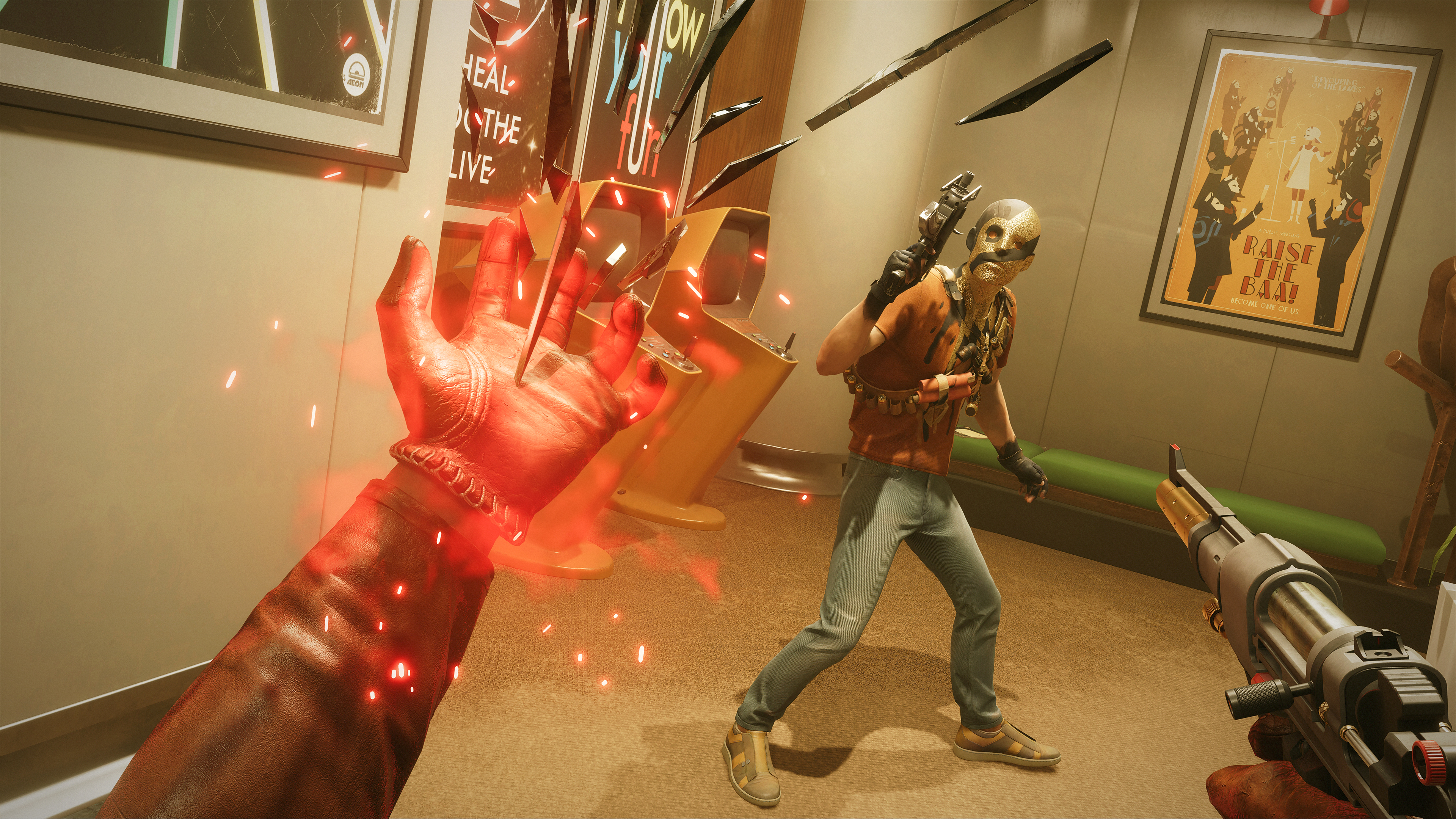 Supercharged powers and stylish designs may make you optimistic about Deathloop, but upon further review, this journey is rougher than you might expect.Bethesda
Supercharged powers and stylish designs may make you optimistic about Deathloop, but upon further review, this journey is rougher than you might expect.Bethesda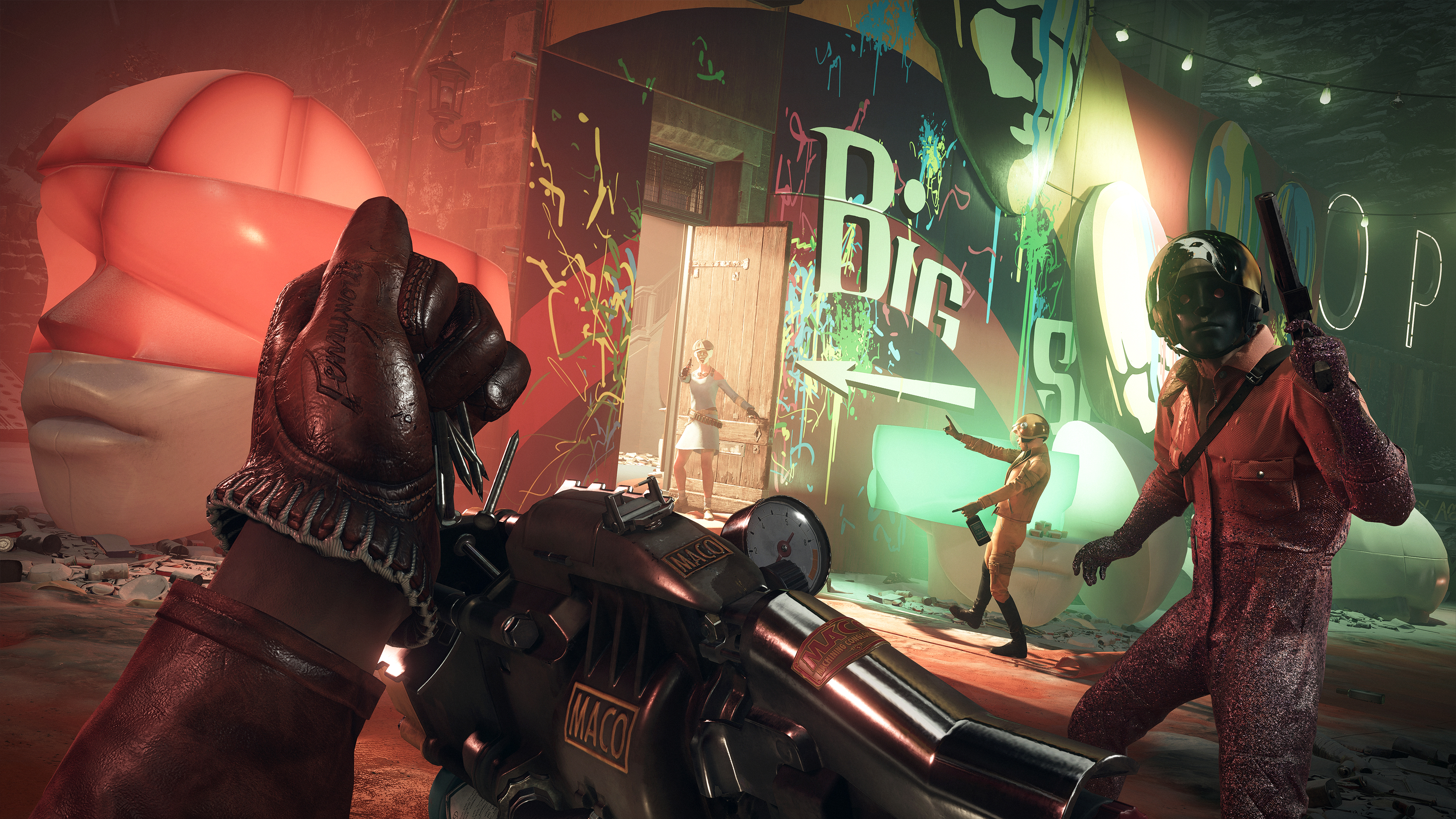 Despite the game's warnings about combat being tough, a mix of dumb AI and overpowered weapons make it far too easy to plow ahead and spray bullets everywhere to win.
Despite the game's warnings about combat being tough, a mix of dumb AI and overpowered weapons make it far too easy to plow ahead and spray bullets everywhere to win.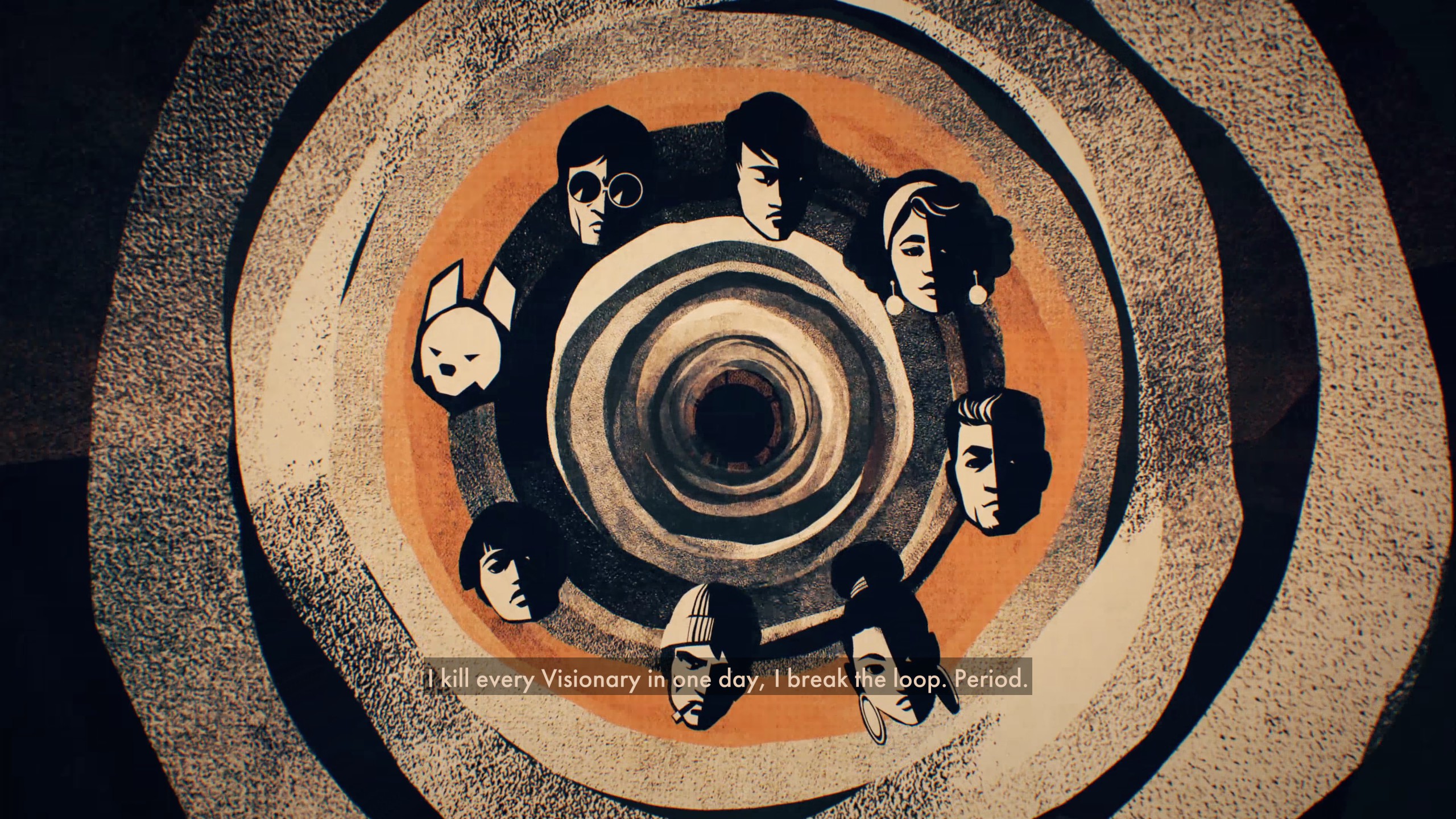 Your mission: Kill all eight "Visionaries." Is that a good idea? Even at the game's outset, it doesn't seem like the brightest idea, but the game's hero, Colt, is determined to do so, anyway.
Your mission: Kill all eight "Visionaries." Is that a good idea? Even at the game's outset, it doesn't seem like the brightest idea, but the game's hero, Colt, is determined to do so, anyway.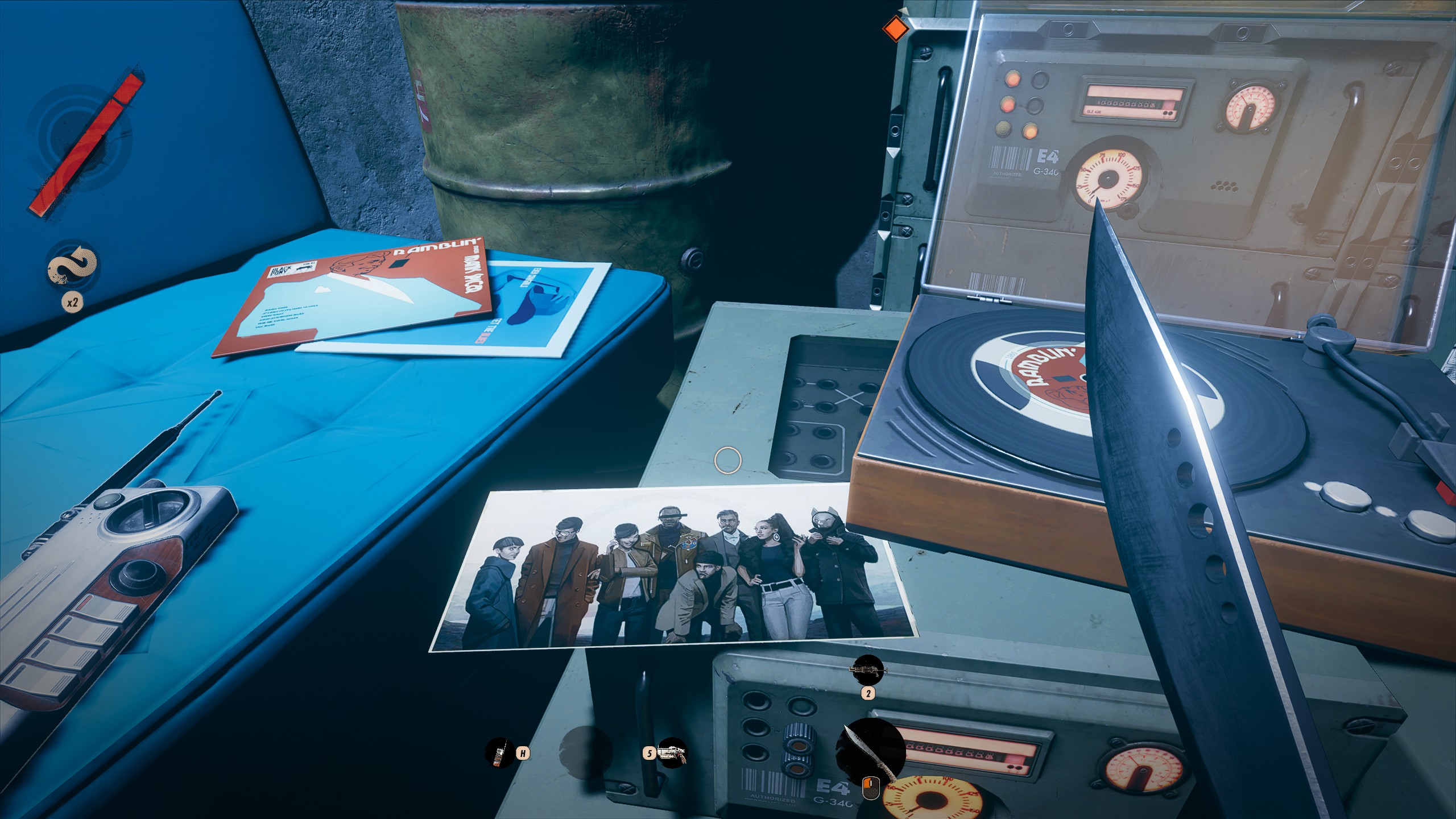 Another shot of the Visionary gang. And is that Colt in there, as well? Interesting.
Another shot of the Visionary gang. And is that Colt in there, as well? Interesting.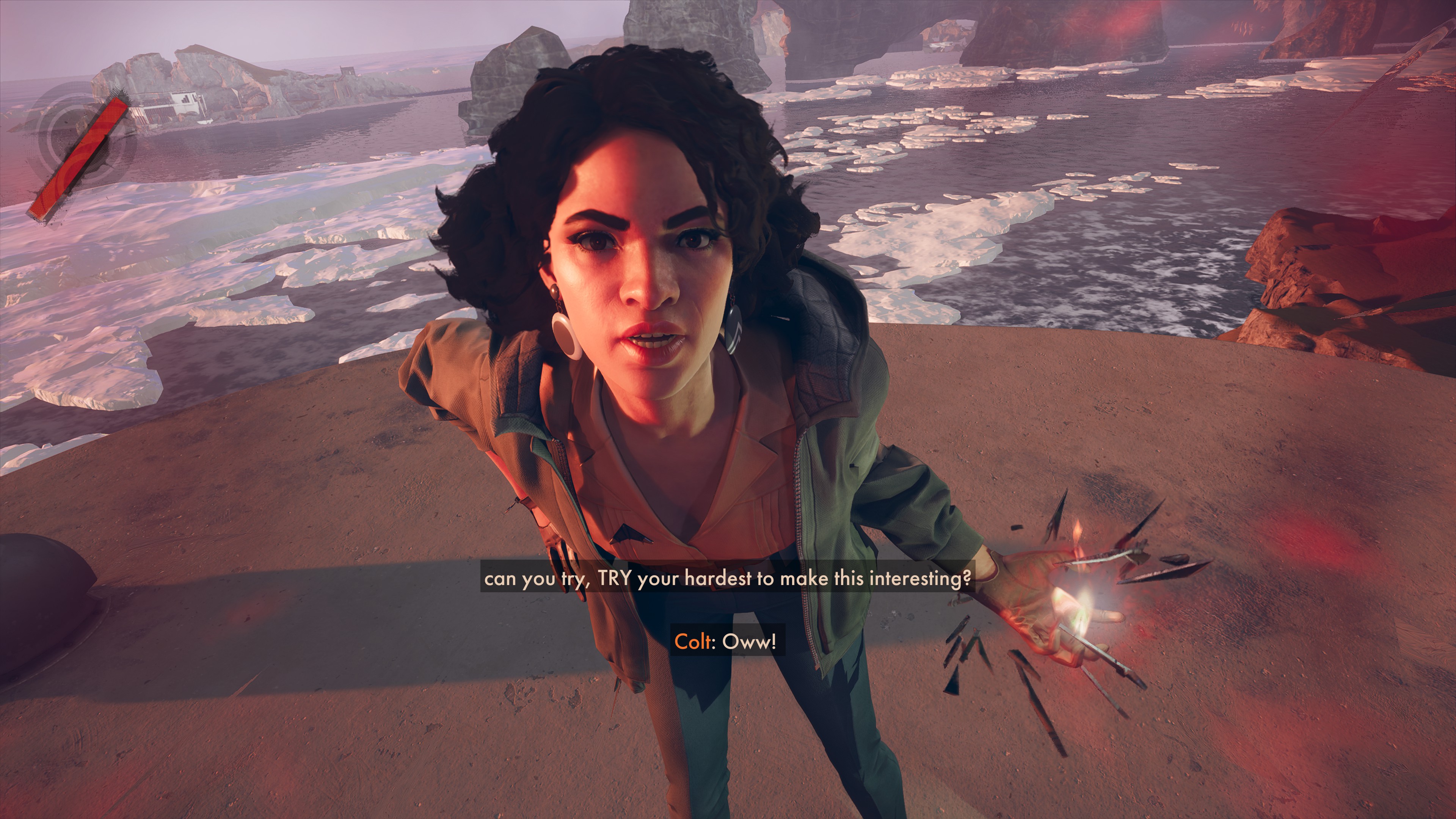 Julianne hunts and taunts you throughout the campaign.
Julianne hunts and taunts you throughout the campaign.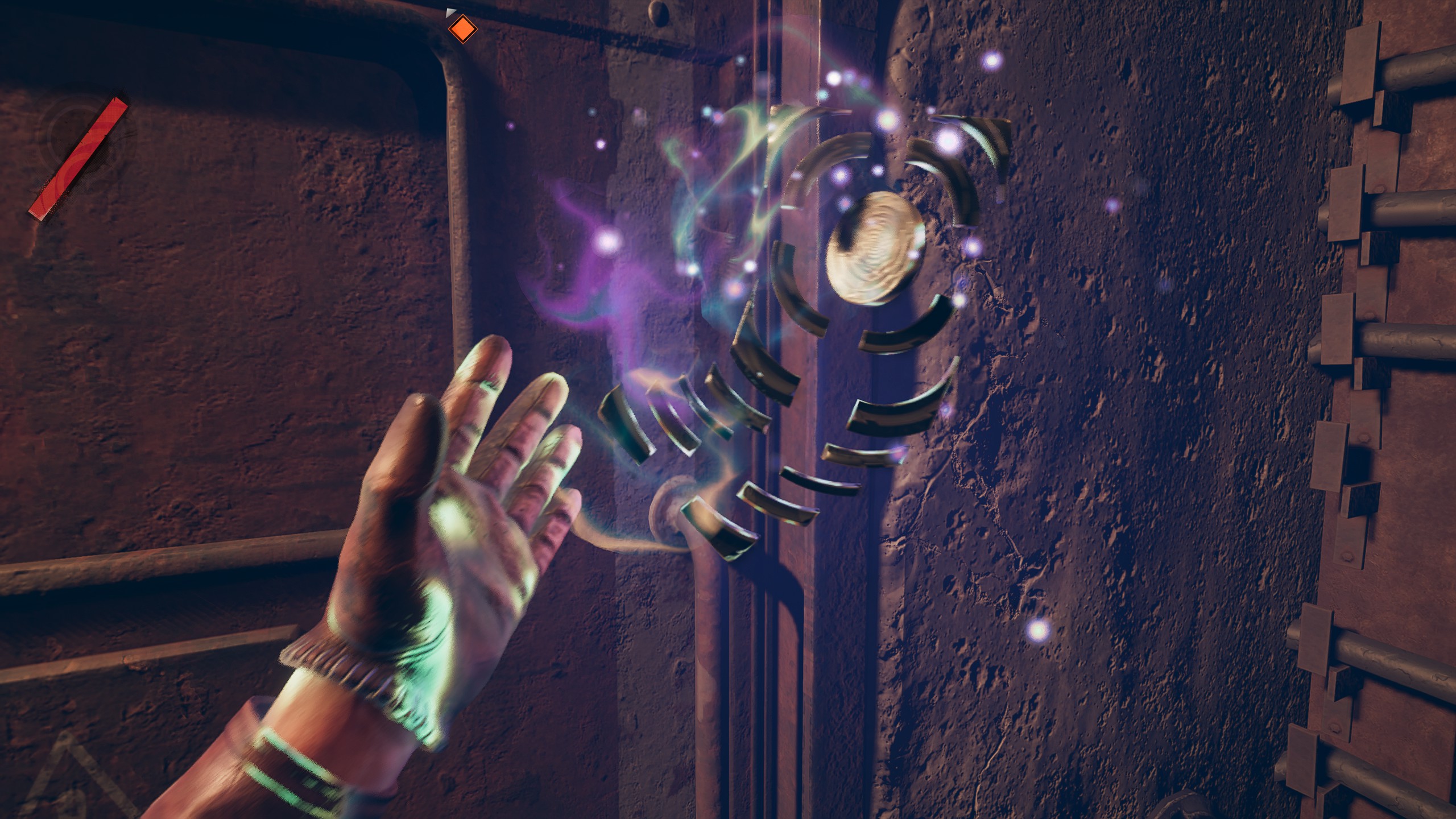 At the game's outset, you discover a mysterious source of power
At the game's outset, you discover a mysterious source of power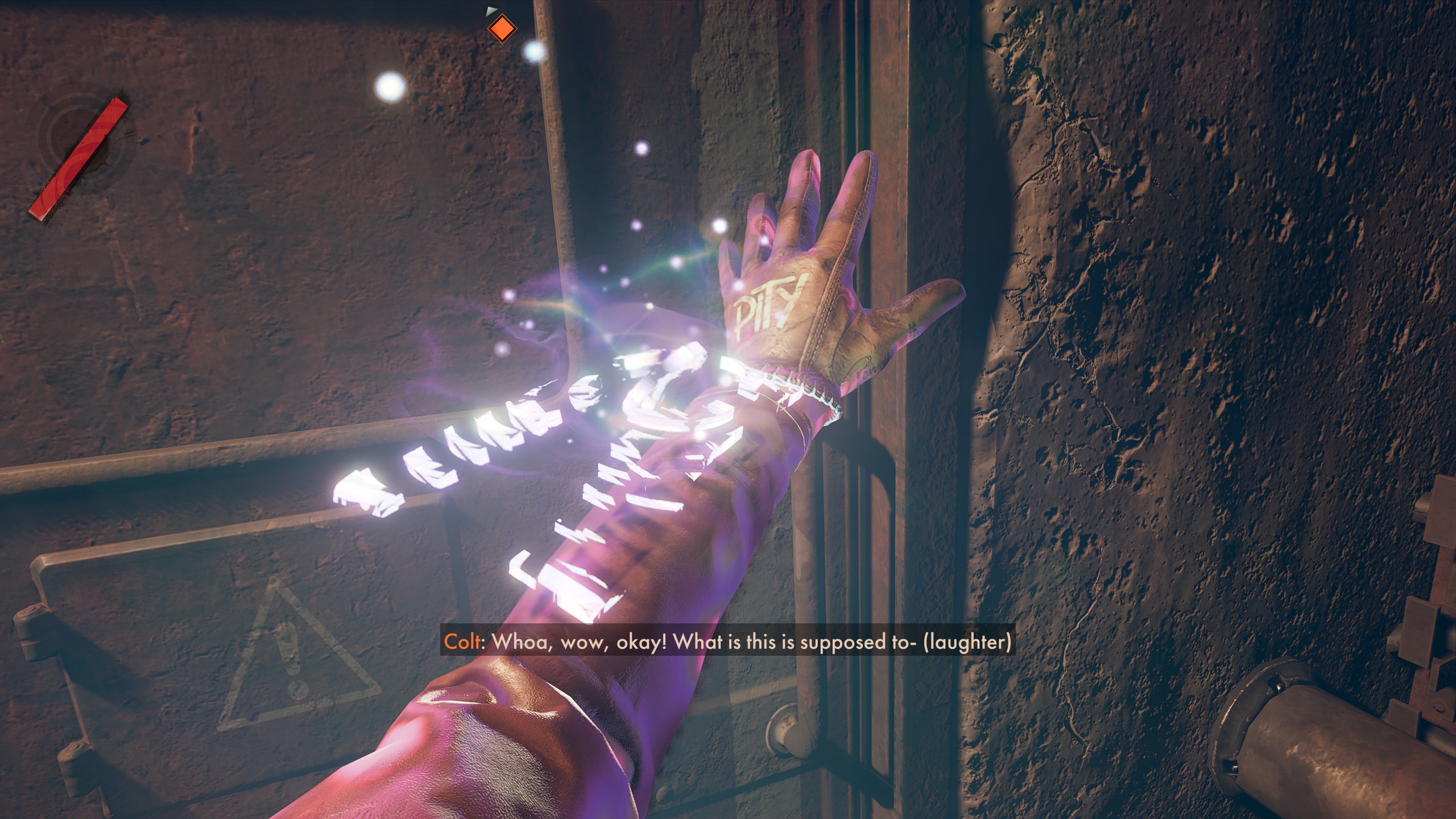 Ooh, it tickles.
Ooh, it tickles.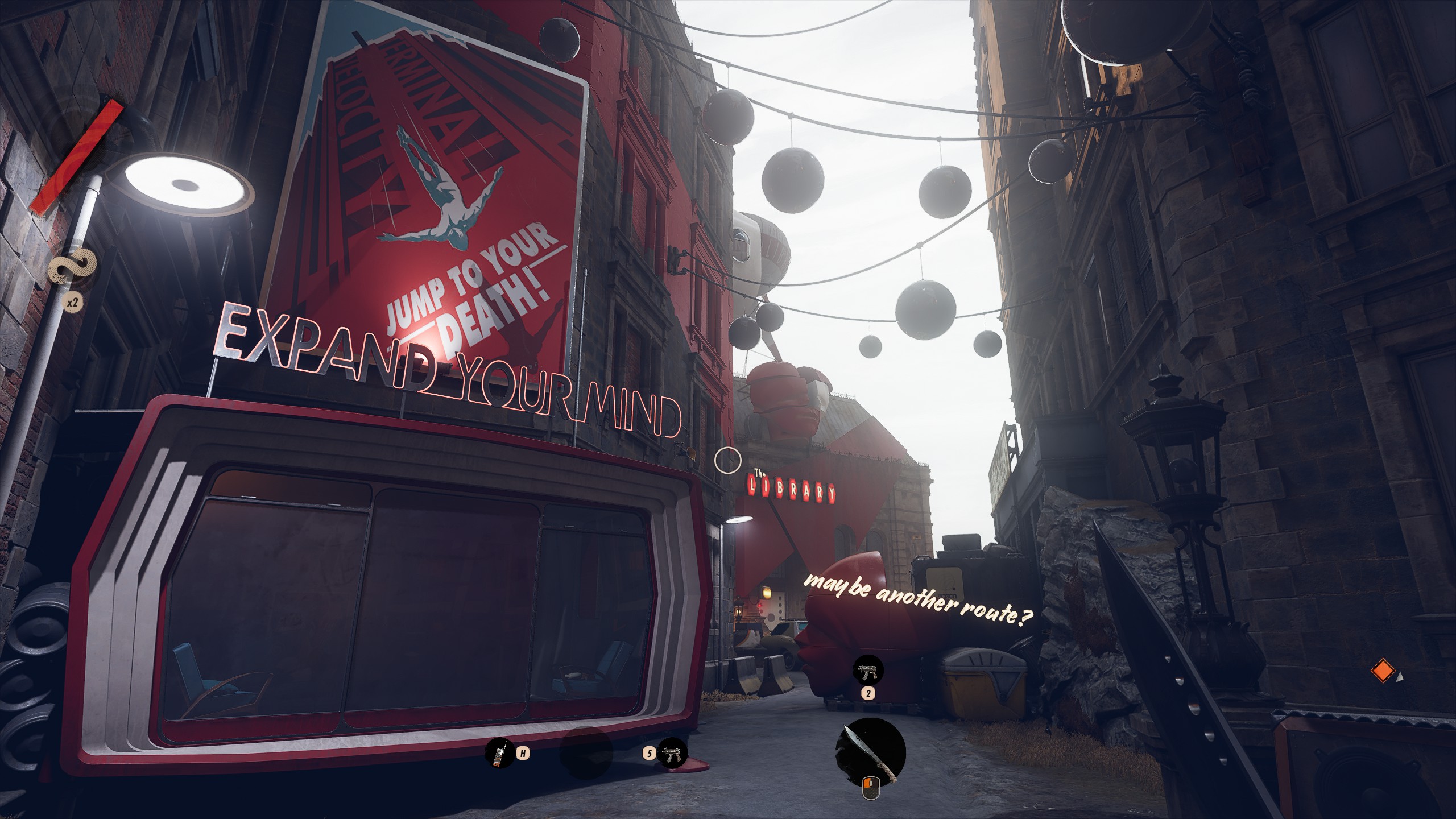 Ominous signs, both built by the locals and appearing in your hallucinations.
Ominous signs, both built by the locals and appearing in your hallucinations.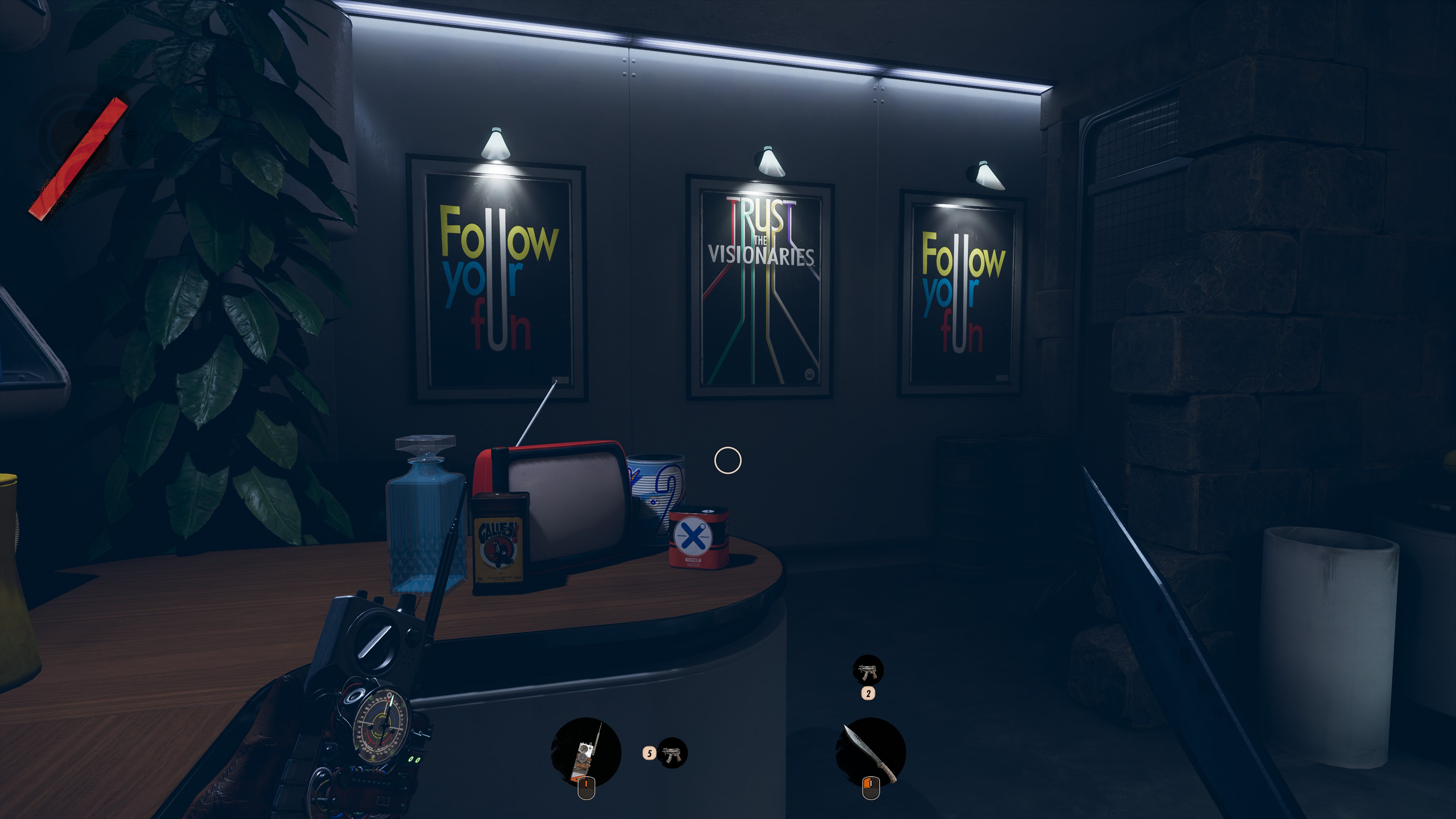 Lots of '70s-inspired posters and art, but they don't really say much.
Lots of '70s-inspired posters and art, but they don't really say much.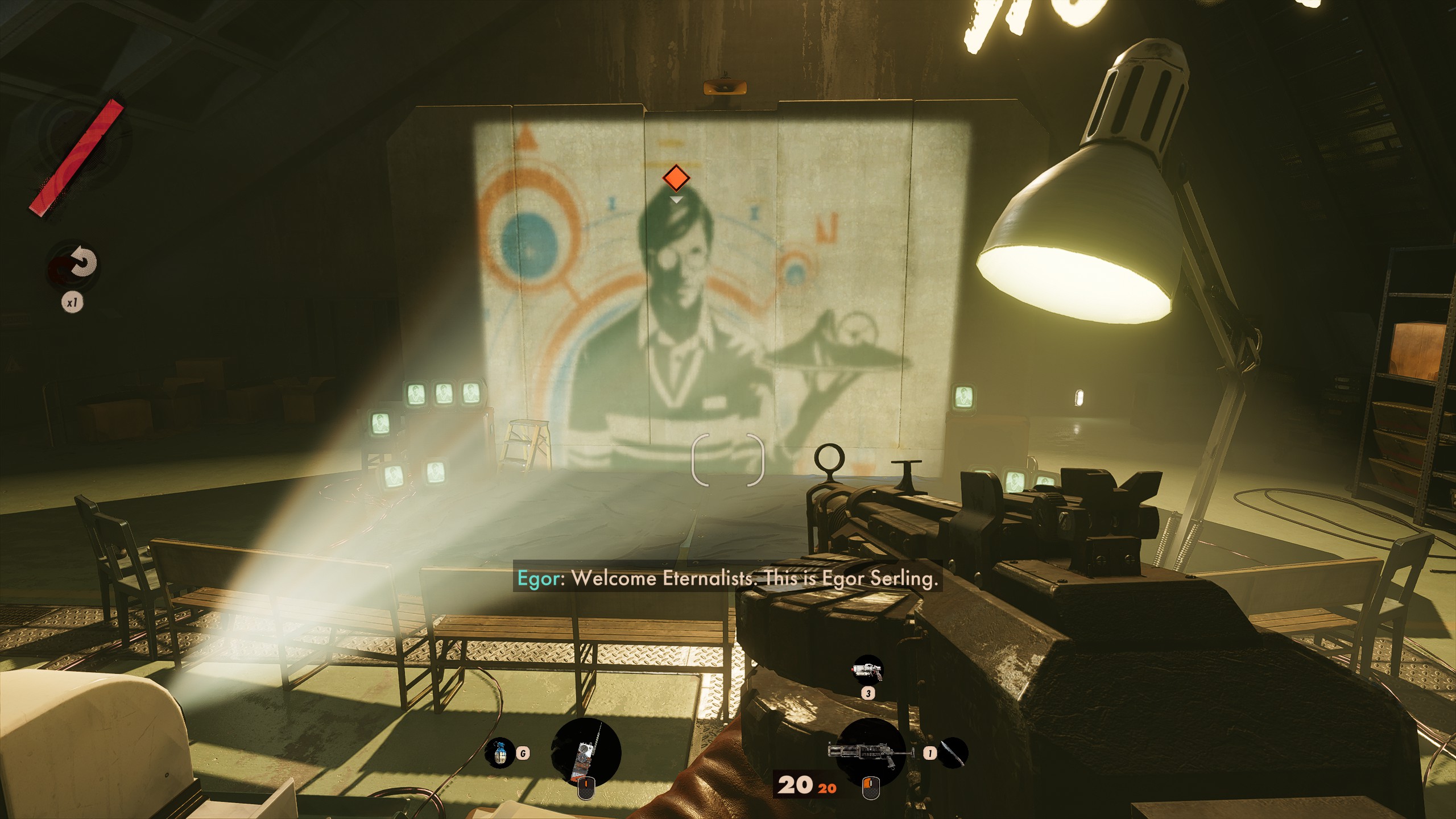 It wouldn't be a time-loop video game without an overwrought explanation of how its science works.
It wouldn't be a time-loop video game without an overwrought explanation of how its science works.
If you're looking for a simple back-of-box quote about how Bethesda's newest video game works, you won't get one. The list of inspirations in Deathloop, out this week on PS5 and PC, is long: the time-loop conceit of Zelda: Majora's Mask; the multiroute sneak-and-sleuth genius of Dishonored; the aesthetics and trippiness of We Happy Few; and Metroid Prime's mix of backtracking and clue-hunting.
What a mouthful! Deathloop is certainly more ambitious than yet another generic shooter, which I appreciate. The studio behind it (Arkane Lyon, creators of Dishonored) can't be faulted for not playing it safe. But ambition alone isn't enough.
You may very well enjoy Deathloop's big swings—and at their best, they combine into something special. But there's no denying the sloppiness players have to wade through to find the good stuff. Even though its core is compelling, Deathloop simply doesn't feel finished. Instead, it seems unpolished, like it was rushed out the door. And its die-and-retry gimmick doesn't make up for a confusing lack of world building or an egregiously small gameplay universe.
Let’s do the deathloop again
Imagine waking up as a full-blown amnesiac inside the world of a complicated video game—that's how Deathloop starts. The game forgoes any introduction or stage-setting cut scenes. Fade from black, and the game's hero, Colt (you, in first-person perspective), screams in confusion as he is assaulted with knife stabs and F-bombs by Julianna, the game's constant antagonist. Moments later, another version of Colt shows up and saves you from a life-ending fall off a cliff. Then he drops you anyway.
You wake up after this brutal end at the exact same place and time, thus confirming the "deathloop" in the game's name. All of your inventory is gone. But this time, at least, your consciousness is retaining memories. No more amnesia. The first thing you remember is a password to open a critical door. From here, you set out to accumulate knowledge and break this time loop. No one clarifies why Julianna keeps trying to kill you or why everyone on this time-bent island doesn't just chill out and enjoy being able to survive death over and over again.
Every time you rewind from death, different things pop up on the beach where you wake: a gun, a hacking device (to unlock doors and remotely disable turrets), a "shard" that enables a special ability, and a "trinket" that buffs up one of your weapons. After the first few hours of gameplay, you'll learn how to "bind" more weapons, shards, and trinkets to your consciousness. That way, they appear on the beach with you every morning, which is useful for the more dangerous scenarios ahead.
Shards are the most Dishonored-like part of your loadout, since they enable magical abilities. Some are rote, like a double-jump (the starting default) and a midair dash. Others are wild, such as Karnesis, which lets you throw enemies' bodies around, and Nexus, which lets you drop a temporary cloud near a crowd of enemies. Hit any enemy in this cloud with an attack, and all the others nearby will feel it. Nexus is a fun way to clear out a cluster of foes who might block your preferred sneaking path.
Visionary quest
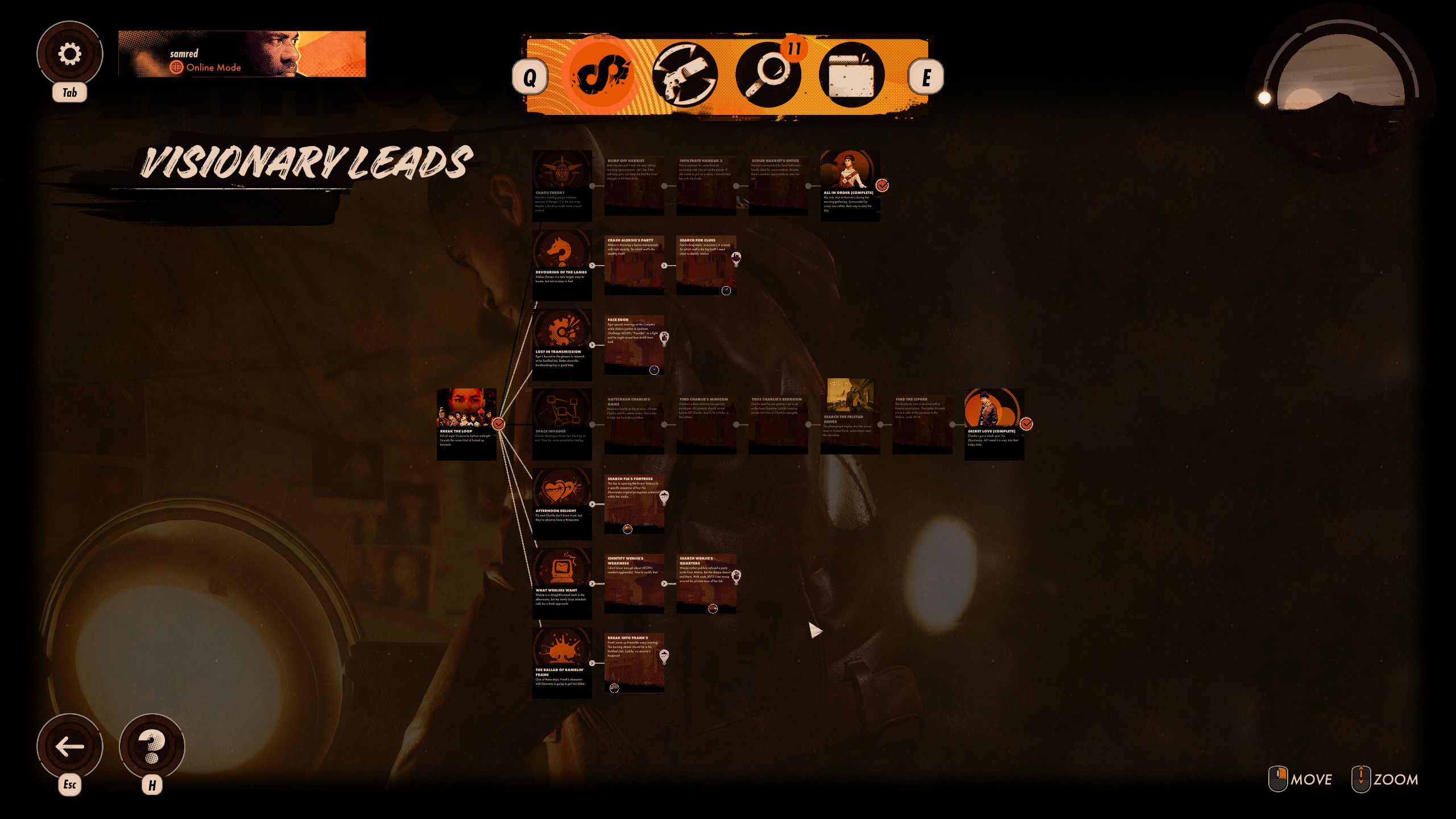 Taking out all eight Visionaries in one day will require accumulating knowledge and items so you can work out the perfect itinerary of death.
Taking out all eight Visionaries in one day will require accumulating knowledge and items so you can work out the perfect itinerary of death.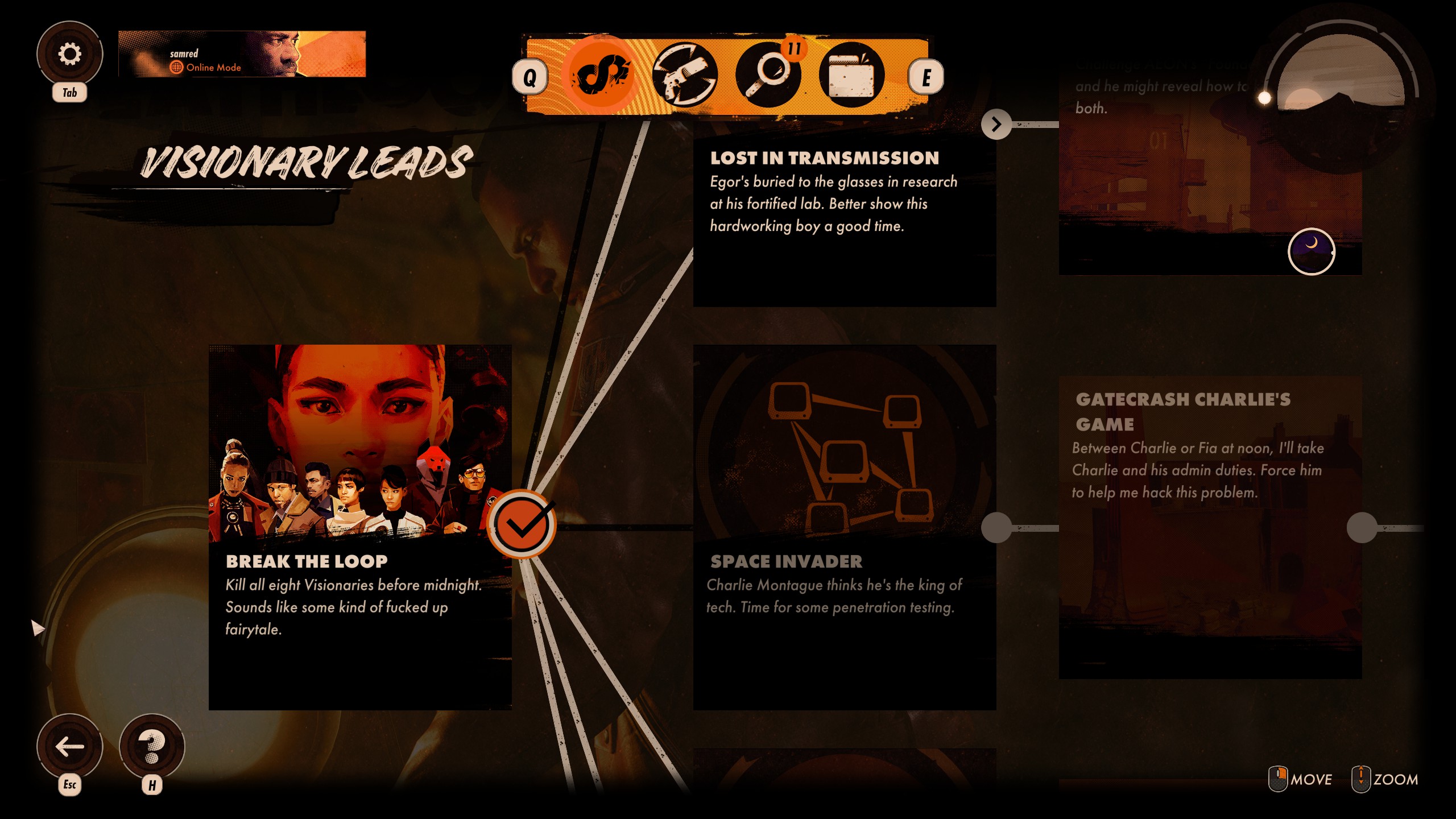 Zooming in on a particular mission will let you track it when you go to the right island zone at the right time of day.
Zooming in on a particular mission will let you track it when you go to the right island zone at the right time of day.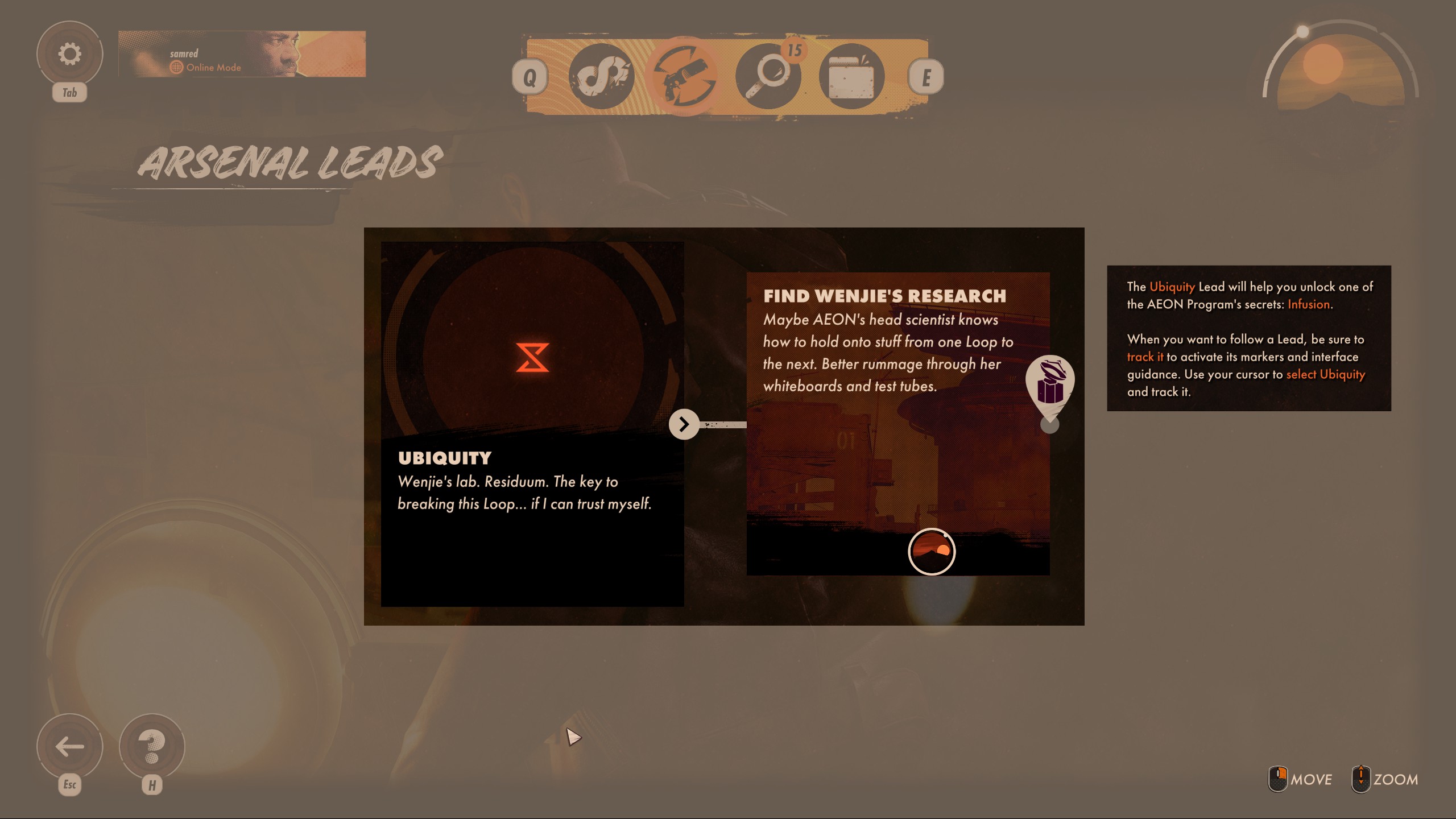 You can also hit up certain zones at certain times to pick up useful abilities, weapons, or items.
You can also hit up certain zones at certain times to pick up useful abilities, weapons, or items.
After about two hours of playtime in Deathloop, you figure out how to break the time loop and escape: Colt must kill all eight "Visionaries" on Blackreef Island. Crucially, he must kill all of them in a single day, which requires getting your daily murder planner down pat. Each day is split into four chunks (dawn, noon, dusk, and evening), and the island itself is broken up into four discrete regions. This isn't a roguelike; the world is static, so its buildings, objectives, and events are consistent. But its events run on a schedule, the same every loop, which makes a place different at dusk than it is at any other time of day.
As an example, you can explore the Updaam district as long as you want with no timer counting down—so long as you get there at dawn. As soon as you leave Updaam, the day moves about four hours ahead. Before you leave, you may stumble upon a clue in Updaam that tells you to come back at dusk. That's when a specific event will unfold that you can interrupt to, say, kill a Visionary or pick up a useful item. But, gosh, I need to go elsewhere at dusk to finish another mission. You know what they say: Why do today what you can delay for the next, uh, time loop?
You die every time you run out the day by leaving an island portion during the "evening" slot. After that, you wake up anew on the aforementioned beach at dawn, equipped with new bundles of intel and newly "bound" weapons and items to do it all over again, looping once more from dawn to midnight. Eventually, you'll gather the knowledge and items necessary to chain together the perfect full-day itinerary, bouncing to the right parts of the island at the right time of day to kill all eight Visionaries.
In good news, Deathloop mostly does a tidy job of tracking the hints and intel you pick up as you explore each corner of the island. Pick through a veritable corkboard of clues to narrow down any hints and outright objectives, then use menu toggles to stick them to your preferred time of day or island region. Usually, you can chain together something useful to do at each time of day, which is good because you'll accumulate "Residuum" points through the course of a full day—and you'll need these points to permanently bind any nifty new items you find to your future loops. If you'd rather skip straight to one time of day, then start the whole day over after finishing a murderous errand. That's easy to do, too.
A slog of a plot
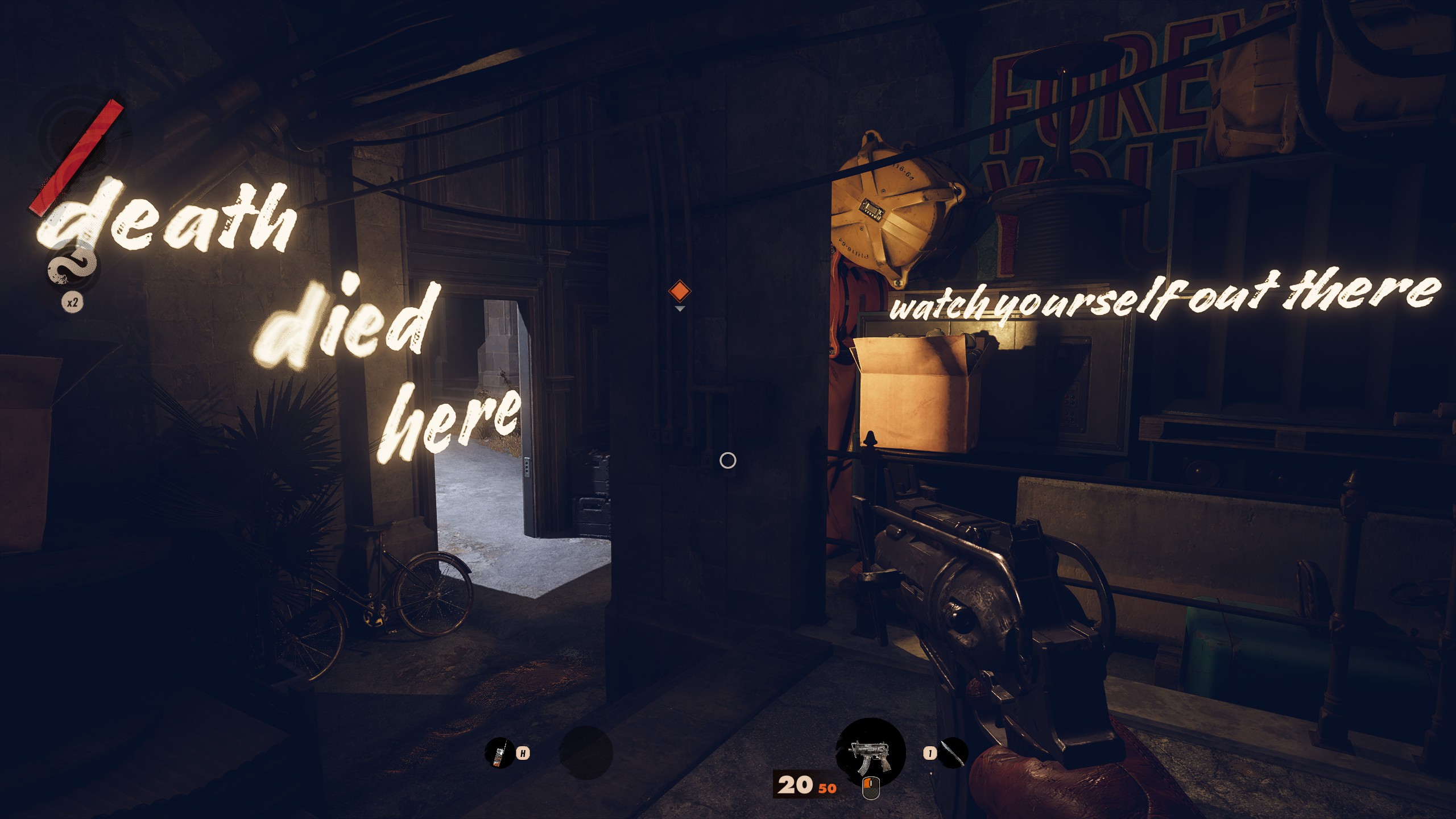 "Death died here." What does that mean? Having played Deathloop for some time, I still have no idea.
"Death died here." What does that mean? Having played Deathloop for some time, I still have no idea.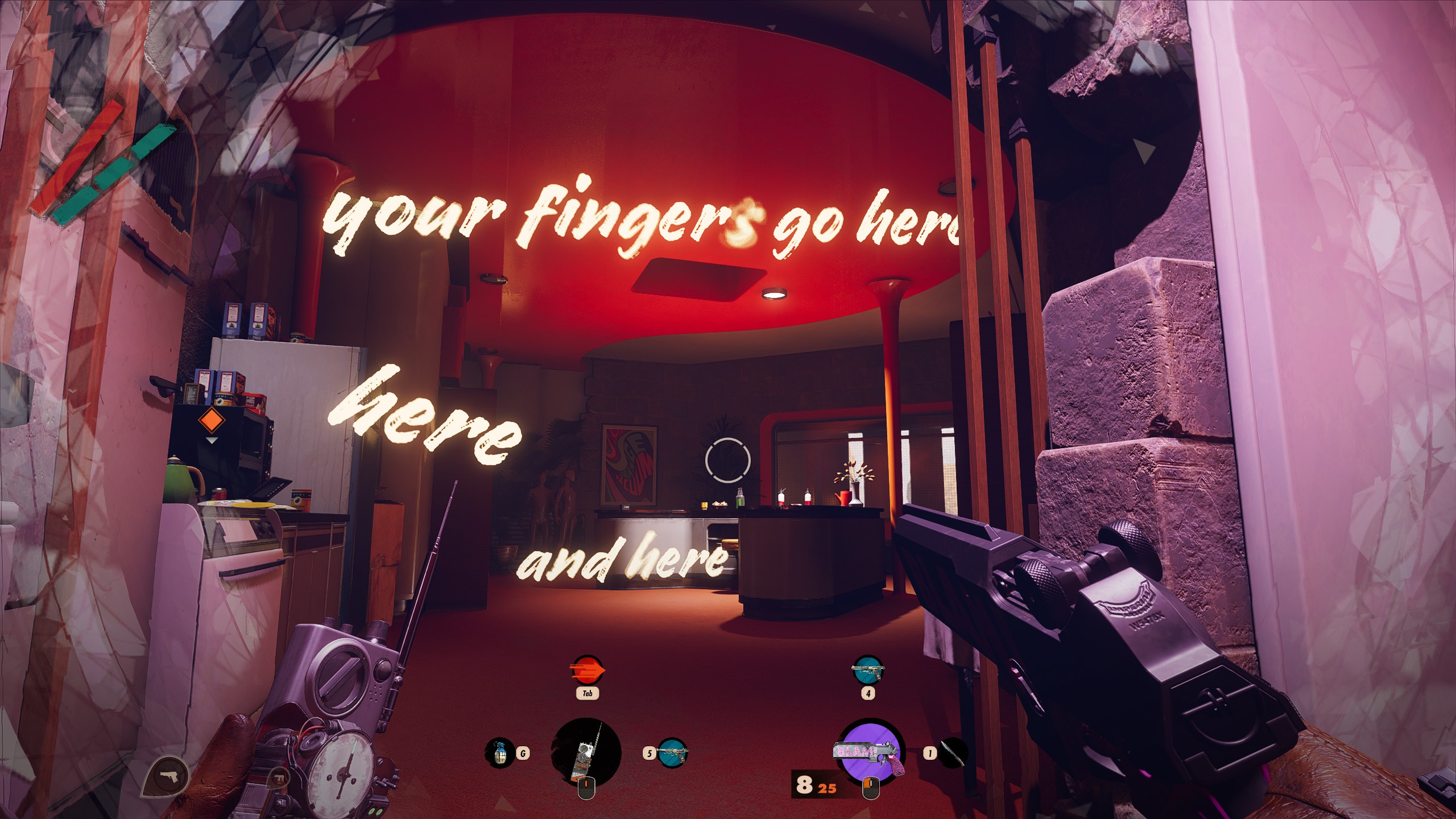 This prompt about putting your fingers in places has nothing to do with the battle ahead. Um.
This prompt about putting your fingers in places has nothing to do with the battle ahead. Um.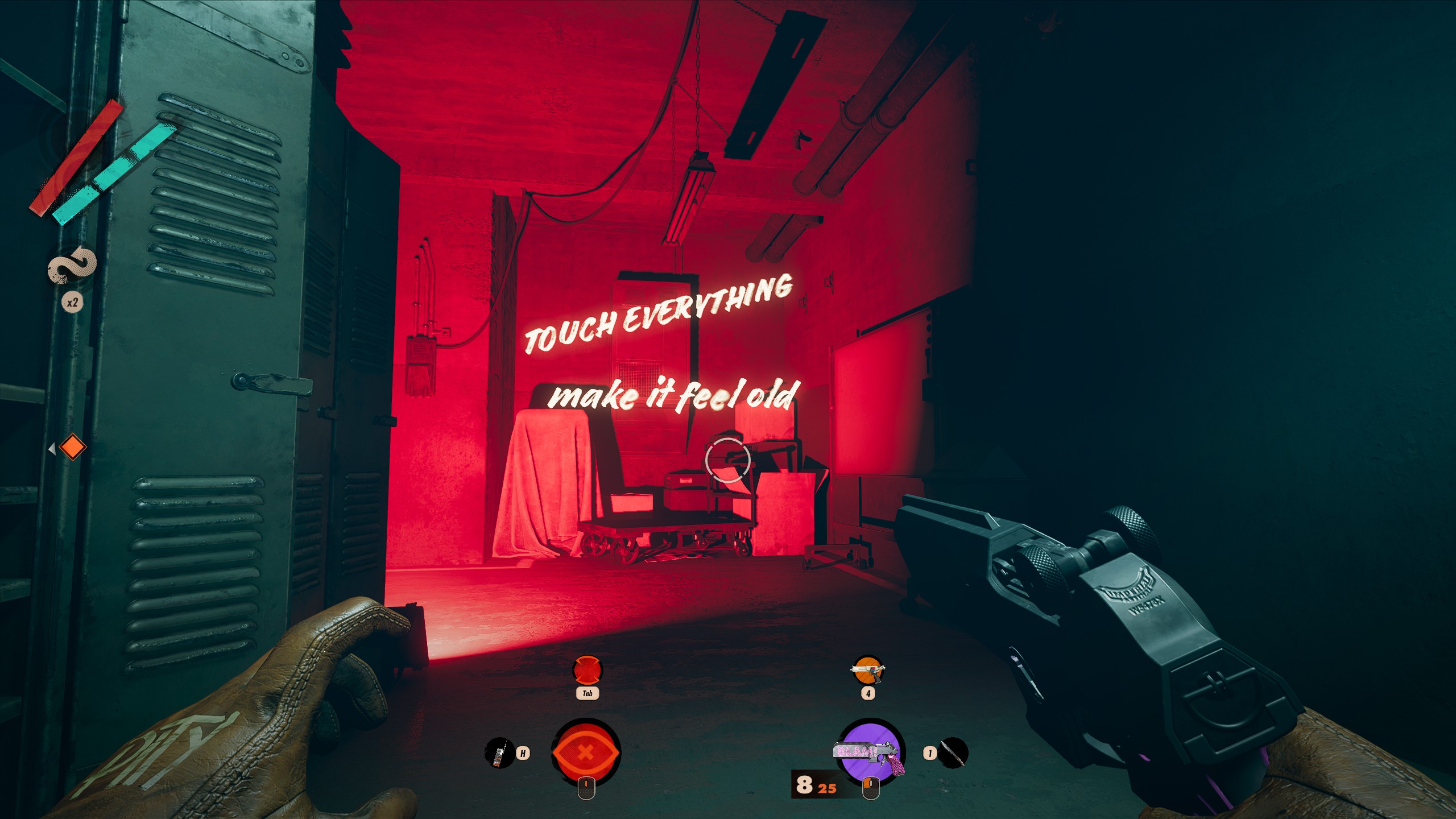 Again: another prompt to touch things, without any relation to what's about to happen. The hallucinatory text throughout Deathloop is generally confusing and distracting.
Again: another prompt to touch things, without any relation to what's about to happen. The hallucinatory text throughout Deathloop is generally confusing and distracting.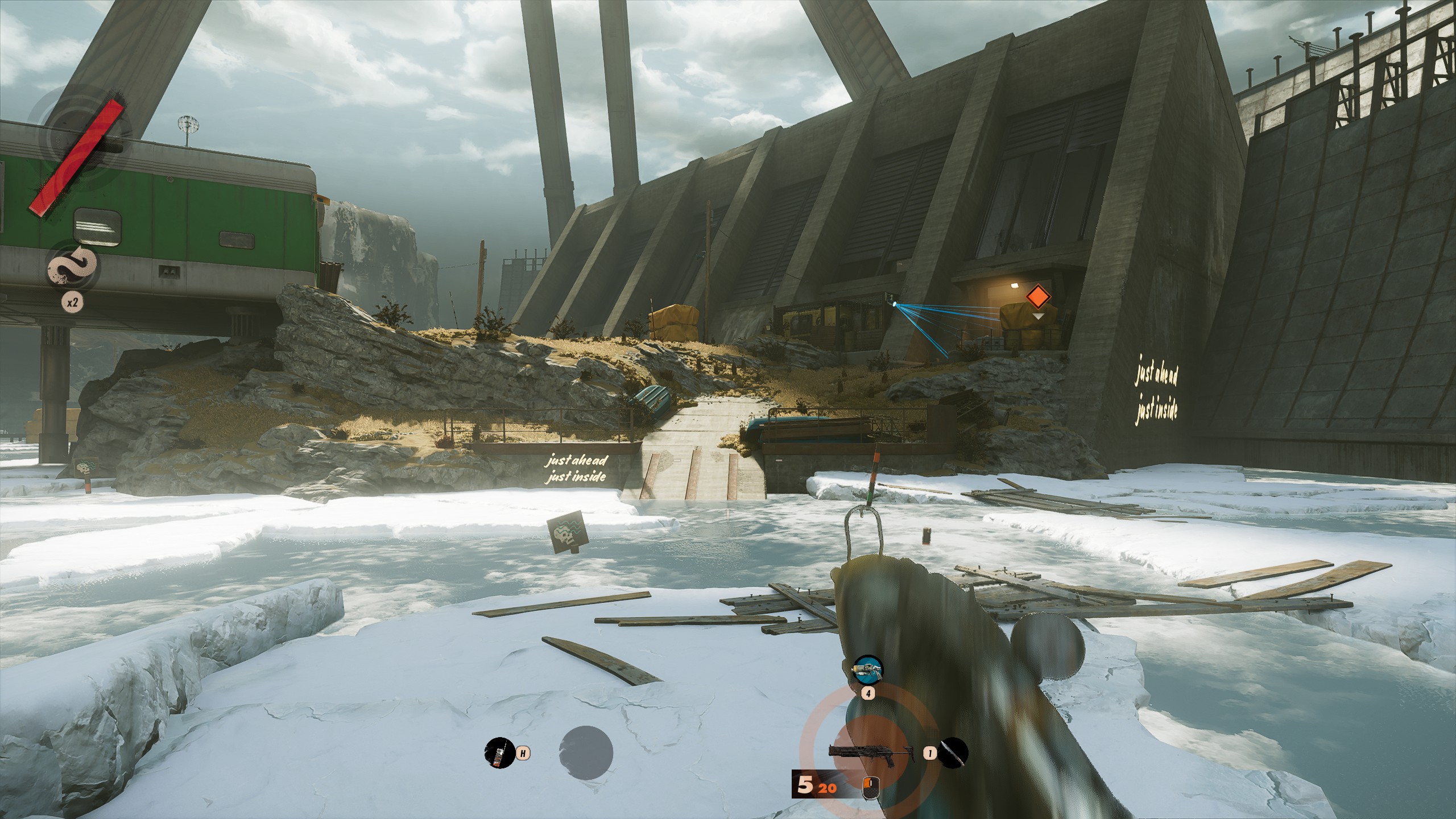 Arguably more useful walls of text, in terms of directing players.
Arguably more useful walls of text, in terms of directing players.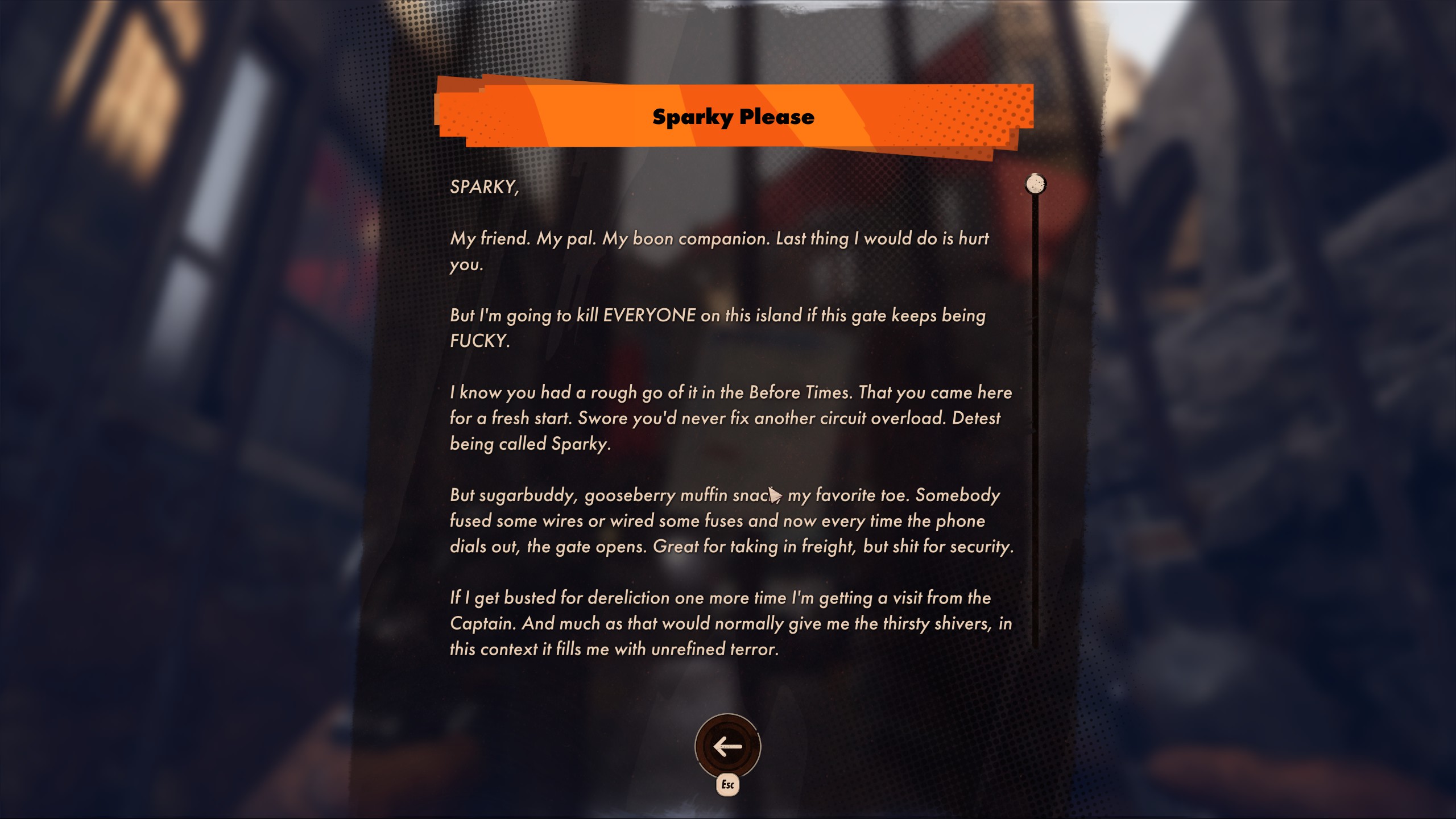 A dump of awkwardly written character development, as found in a diary.
A dump of awkwardly written character development, as found in a diary.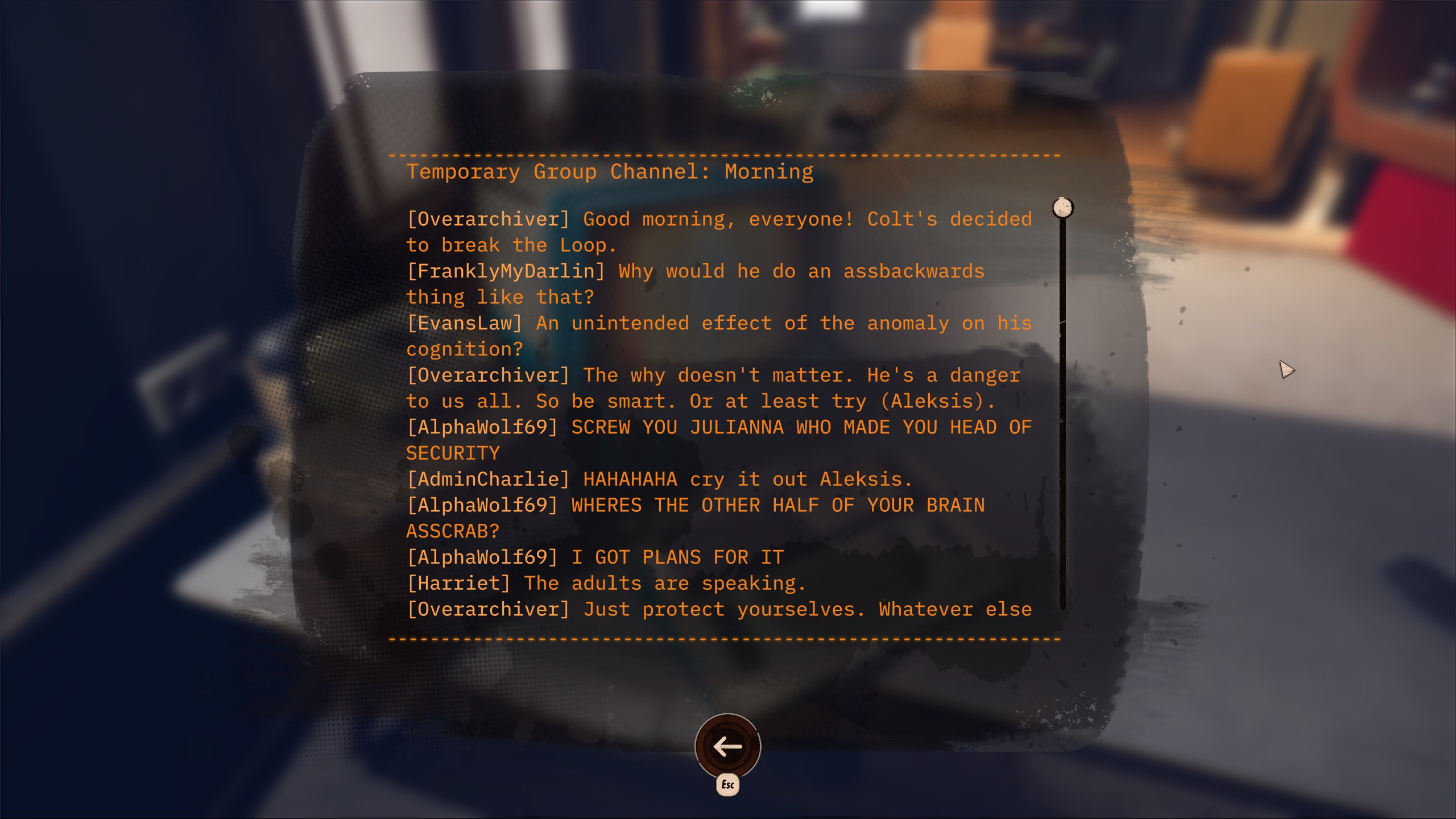 A dump of awkwardly written character development, as found in a chat terminal.
A dump of awkwardly written character development, as found in a chat terminal. A question so benign, they wrote it two times.
A question so benign, they wrote it two times.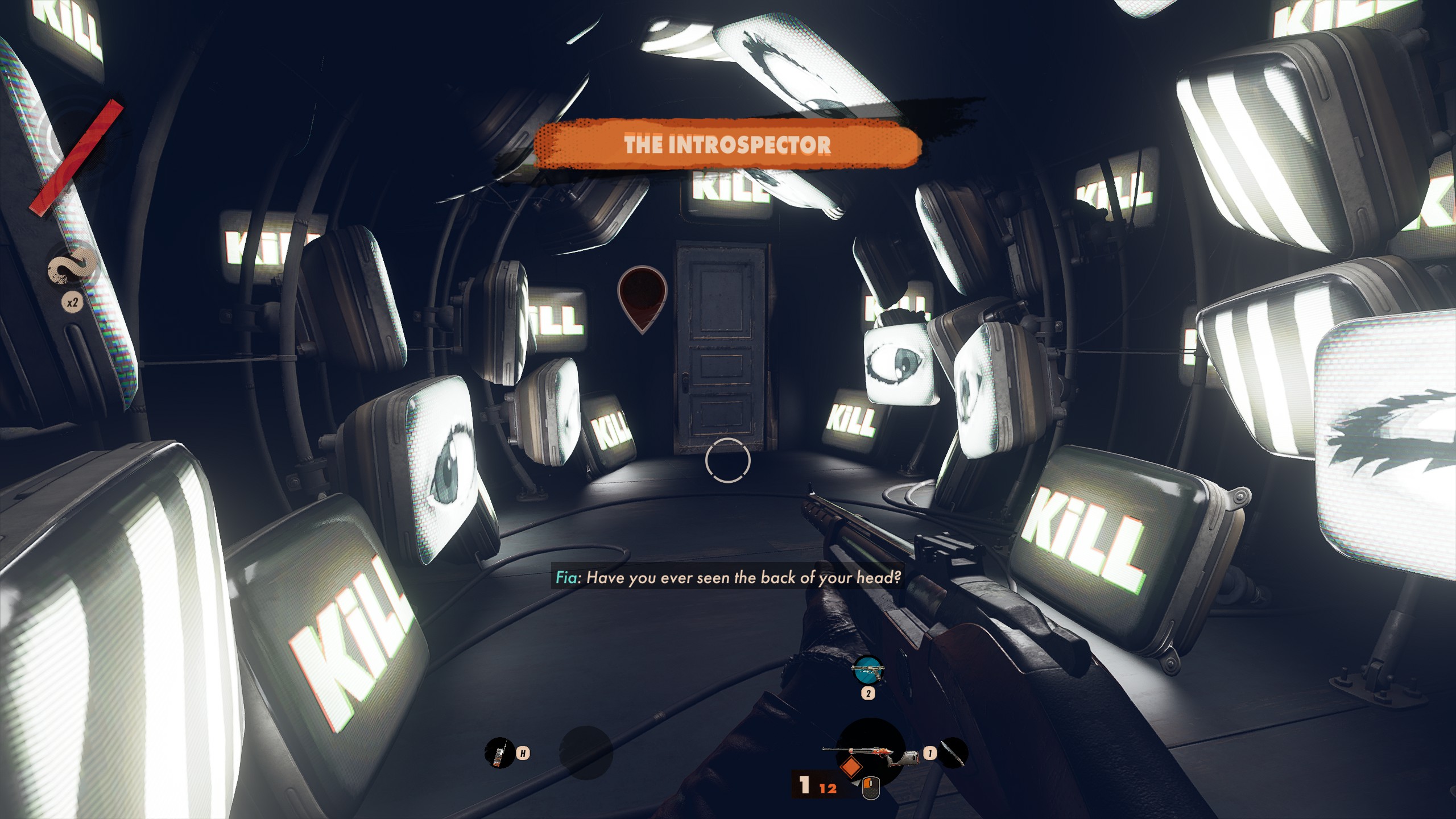 I still don't understand what this specific room is meant to convey.
I still don't understand what this specific room is meant to convey.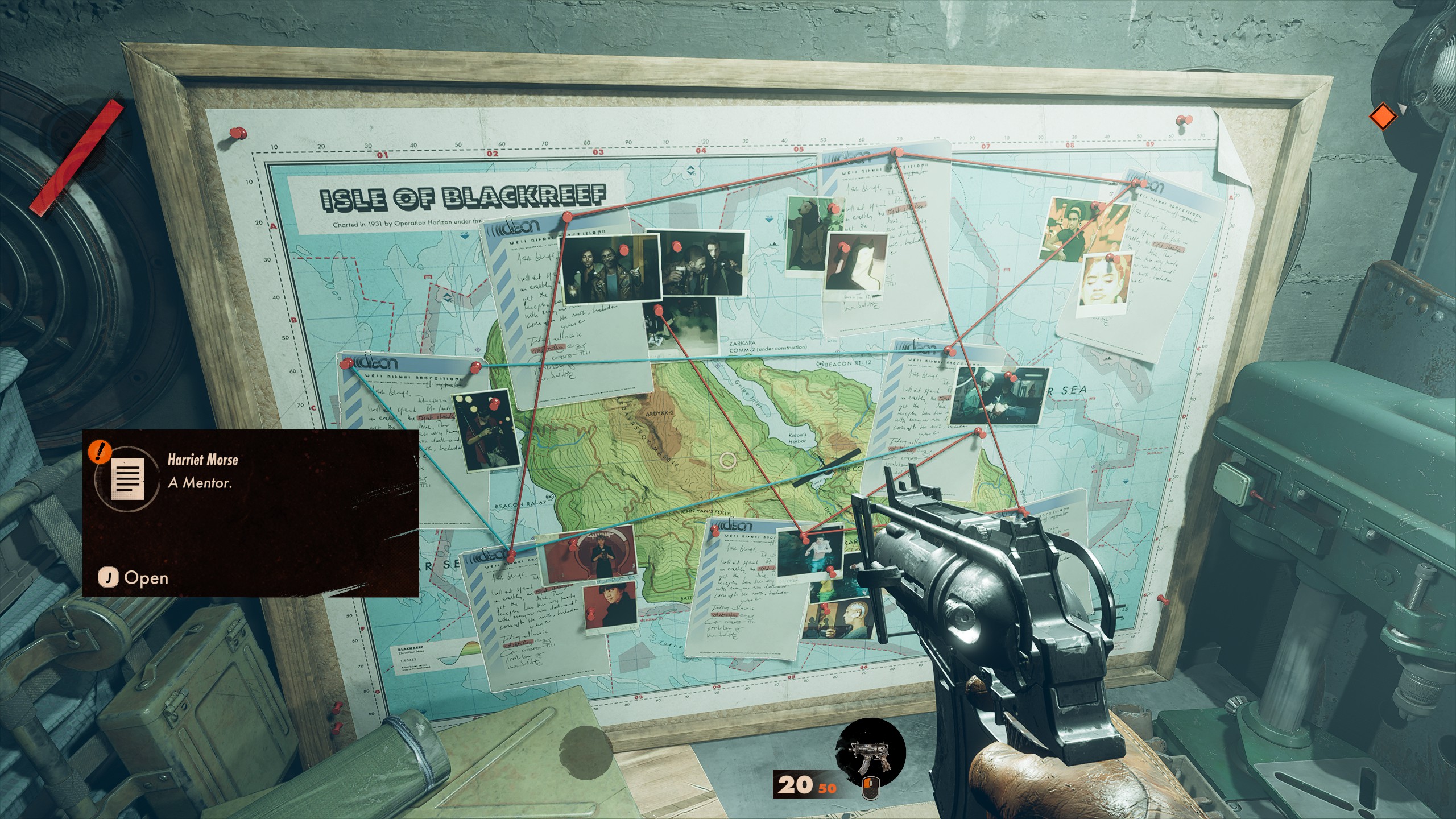 The game's cast of Visionaries, mapped out on a corkboard.
The game's cast of Visionaries, mapped out on a corkboard.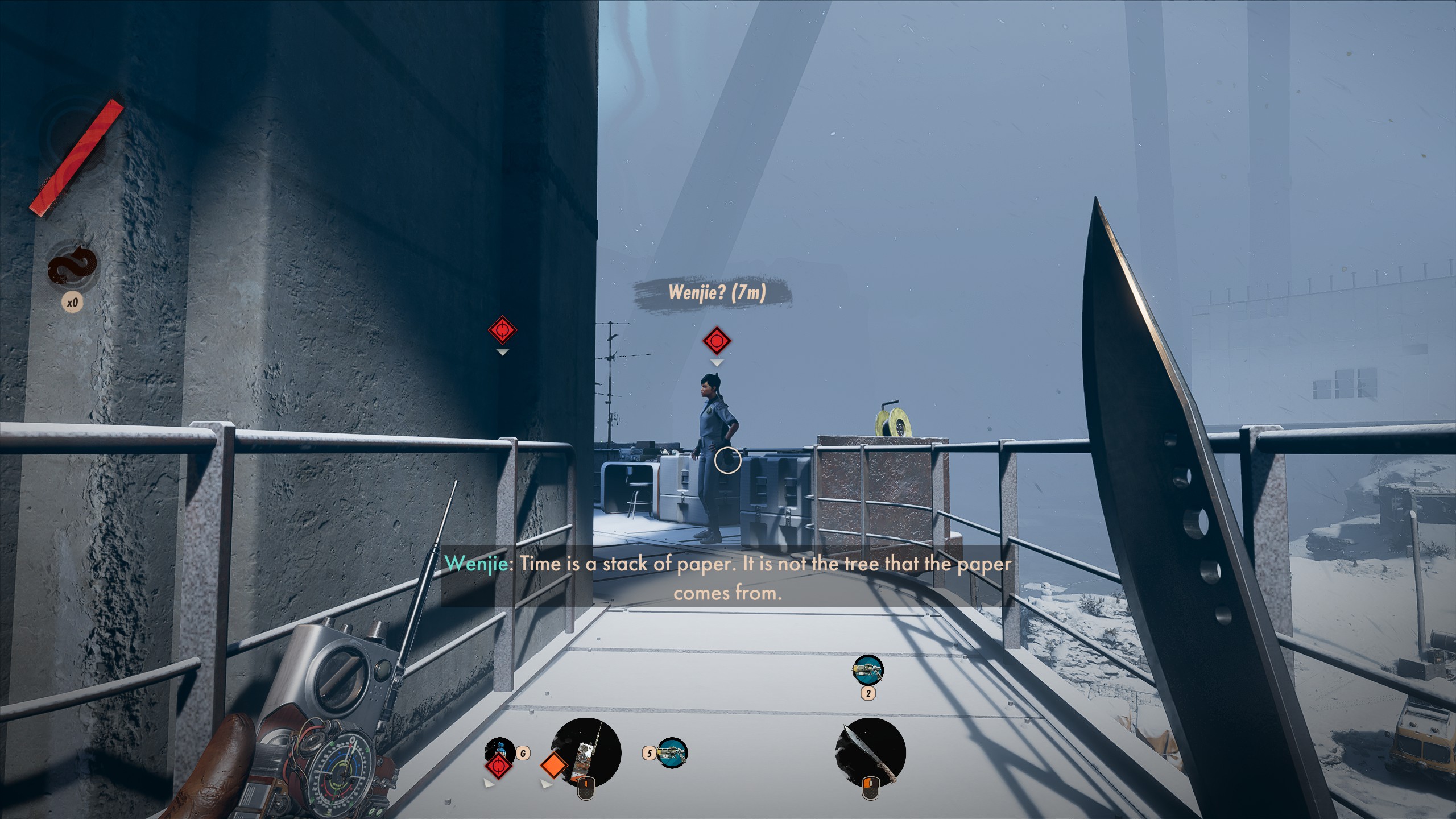 Sometimes, you learn about characters by sneaking up and listening to them ramble before killing them. But this is the exception, not the rule, in Deathloop.
Sometimes, you learn about characters by sneaking up and listening to them ramble before killing them. But this is the exception, not the rule, in Deathloop.
Sounds intriguing, right? Well, that's only because I was talking you through it.
Deathloop's opening is so obsessed with creating attitude and confusion that it fails as a gameplay introduction. Hints of each Visionary litter the island before you have any idea who they are, how many there are, or what their deal is. And you'd think the blocks of text that Colt sees over walls or in hallways would be useful. But no—they're either head-smackingly obvious tips ("go underground") or portentous nonsense ("Death died here," "They've got no idea, no idea at all").
The constant chatter between Julianna and Colt over a radio system is equally useless. Mostly our two narrators are just trying to see who can swear more. Because Julianna has no interest in helping Colt, she uses the bulk of her air time to taunt and confuse him—but guess what, Arkane? Colt isn't a real person. Deathloop's players are. And your narrative approach does them no favors.
To piece together the game's cast, players must paw through notes, diaries, computer terminals, and audio logs, much like in Fallout and BioShock. But without any early anchor for how Deathloop's island functions or how characters relate to each other, it takes a long time before any of this content begins to click. This wouldn't be so bad if the game's buildings, posters, statues, or hallucinatory texts delivered their own storytelling—maybe which Visionary lives where, what their belief system is, and how each cast member interacts with the others. Instead, the game's visual design focuses mostly on how outlandish the Visionaries are or how Colt is an intruder who needs to be stopped.
Deathloop's missions eventually string together a vague story of the Visionaries' crisscrossing relationships. Clearly, someone at Arkane tried building a cohesive world where these characters grapple with the high-concept weirdness that keeps the islanders not only trapped in a time loop but also able to interact with clones of themselves. When it's good, it's classic, Bethesda-at-its-best storytelling. There are a few moments where Deathloop's plot shines in unique, only-in-games ways—especially when you sneak up on certain characters talking to clones of themselves. But such highs only make Deathloop's general plot failures all the more disappointing.
Brevity, limited powers, limited AI
Forget plot, though. What if you're the kind of player who mashes the "skip plot" button and is just here for the Arkane-caliber questing? Too bad—Deathloop's gameplay is far from transcendent.
The biggest trouble lies in the game's brevity. The four primary island sections are all alarmingly small, and while various buildings open up or get bigger crowds at different times of day, the results are nowhere near, say, a Zelda "second quest" cache of remixed content. By the time Deathloop's two-hour opening chunk completes, you'll have passed by a huge majority of the game's buildings, outdoor stretches, and even underground caverns.
This is where backtracking comes into serious play. Need to unlock a door? Figure out which place to be, at which time of day, in order to find the clue that might lead you to the padlock code for said door. There's a lot of that in Deathloop. (Sorry, speedrunners: the game randomly assigns padlock codes, so you can't load an FAQ and expect to get through most of Deathloop's doors.)
Without larger regions to fight in or sneak about, Arkane doesn't offer many creative paths to fulfilling each step in a mission chain; it's a stark contrast to the sense of wonder Dishonored games enjoyed. Worse, Deathloop's superpowered shards don't approach anything near the sneak-friendly weirdness of Dishonored's abilities, like turning into a rat. You expect Dishonored games to combine creative superpowers and myriad paths to get past demanding, tricky scenarios, but Arkane doesn't live up to its past reputation this time.
 Faceless, masked enemies rarely do anything beyond shoot a gun or slash at you with a knife.
Faceless, masked enemies rarely do anything beyond shoot a gun or slash at you with a knife.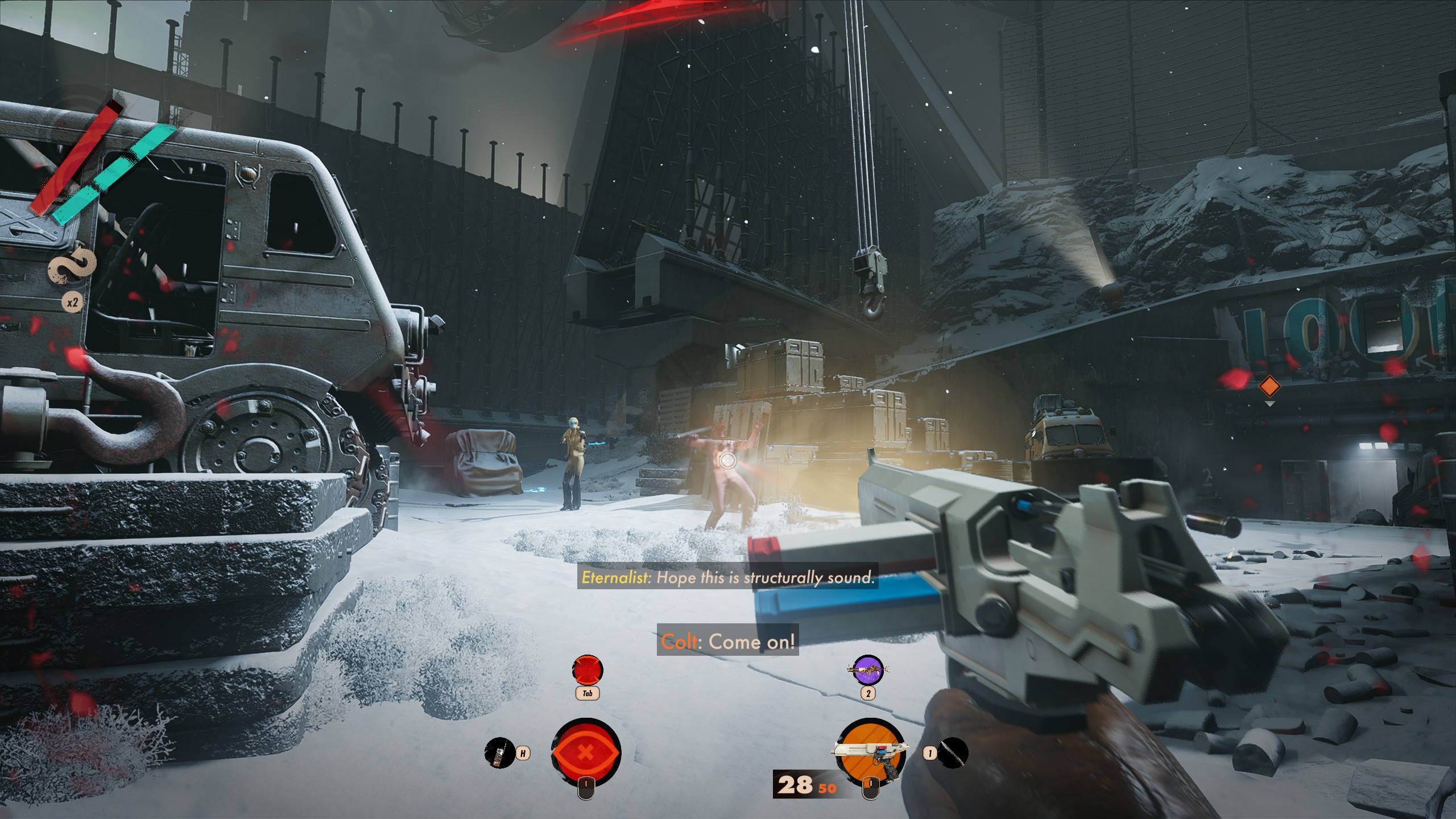 So long as you can narrow down any moment of combat to one-on-one or two-on-one, you'll be fine. Should you die, you can safely respawn twice before you're abruptly booted to the beginning of the time loop again (and lose any "unbound" pickups in the process).
So long as you can narrow down any moment of combat to one-on-one or two-on-one, you'll be fine. Should you die, you can safely respawn twice before you're abruptly booted to the beginning of the time loop again (and lose any "unbound" pickups in the process).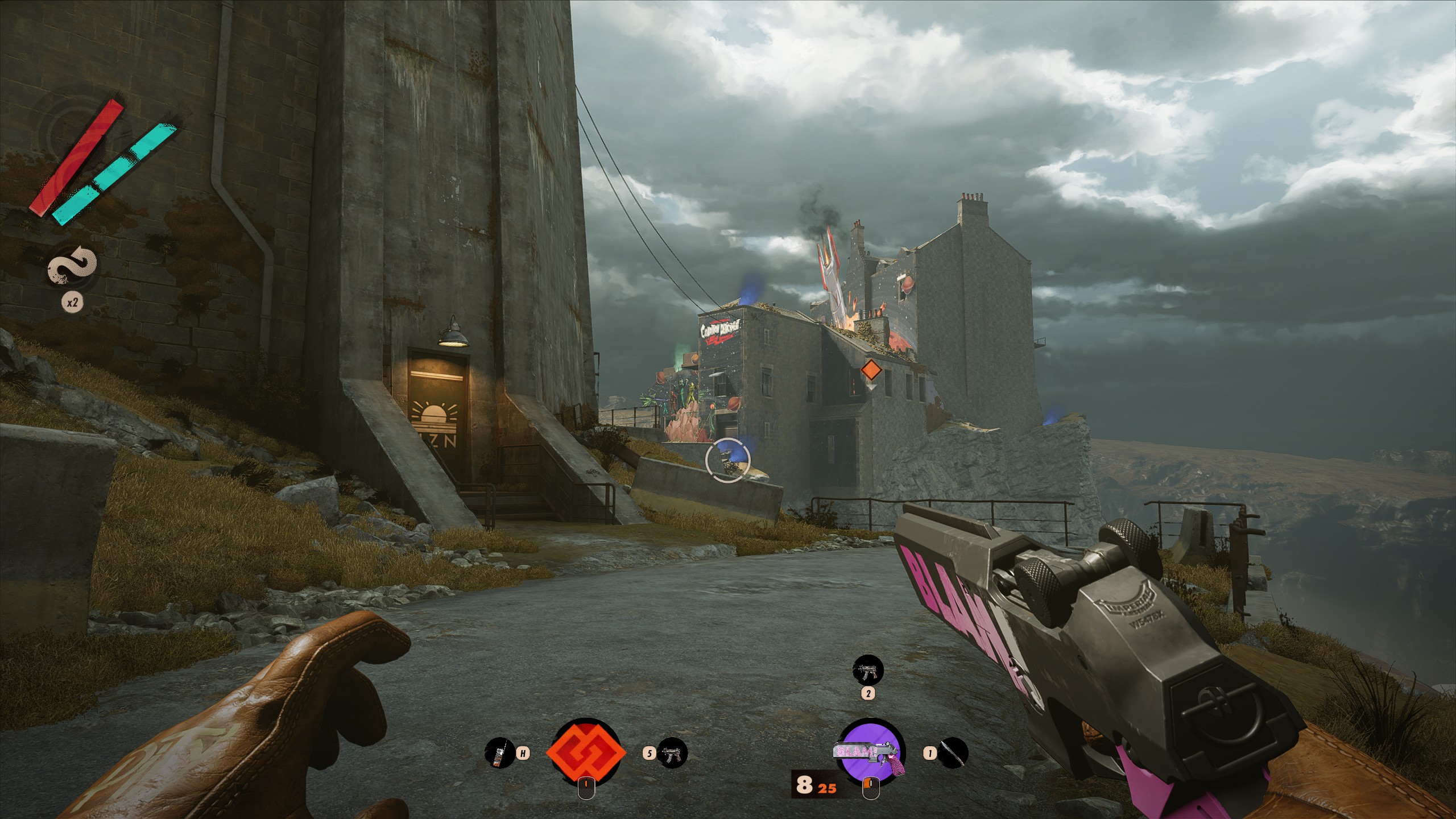 The castle ahead seems like an intriguing combat candyland when seen from a distance. Sadly, its paths are quite bland compared to the best in Dishonored, and that drop in quality is a recurring theme in this newer Arkane Lyon game.
The castle ahead seems like an intriguing combat candyland when seen from a distance. Sadly, its paths are quite bland compared to the best in Dishonored, and that drop in quality is a recurring theme in this newer Arkane Lyon game.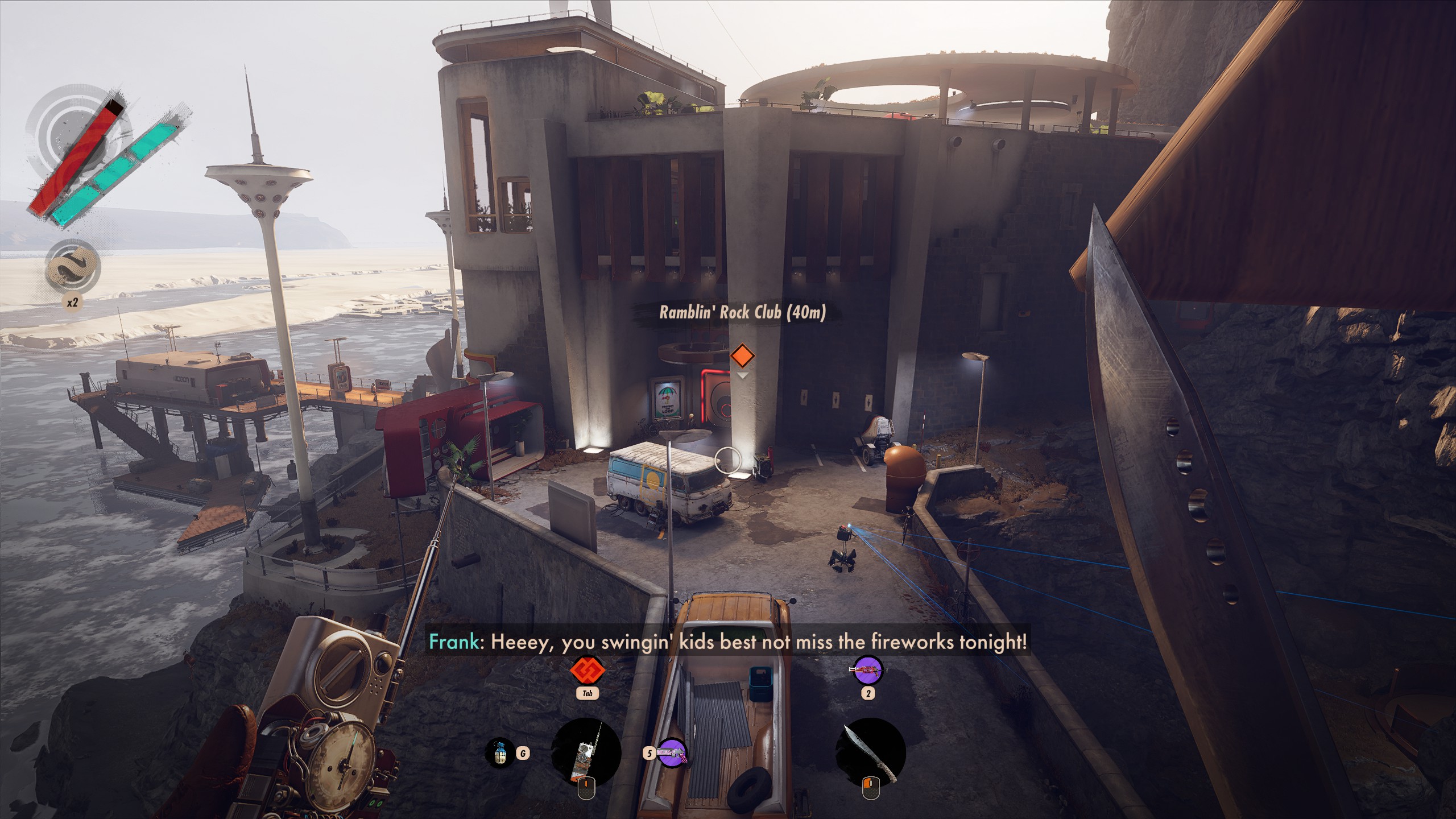 This somewhat guarded compound is a bit more interesting to sneak-and-slash through, but not by large measures.
This somewhat guarded compound is a bit more interesting to sneak-and-slash through, but not by large measures.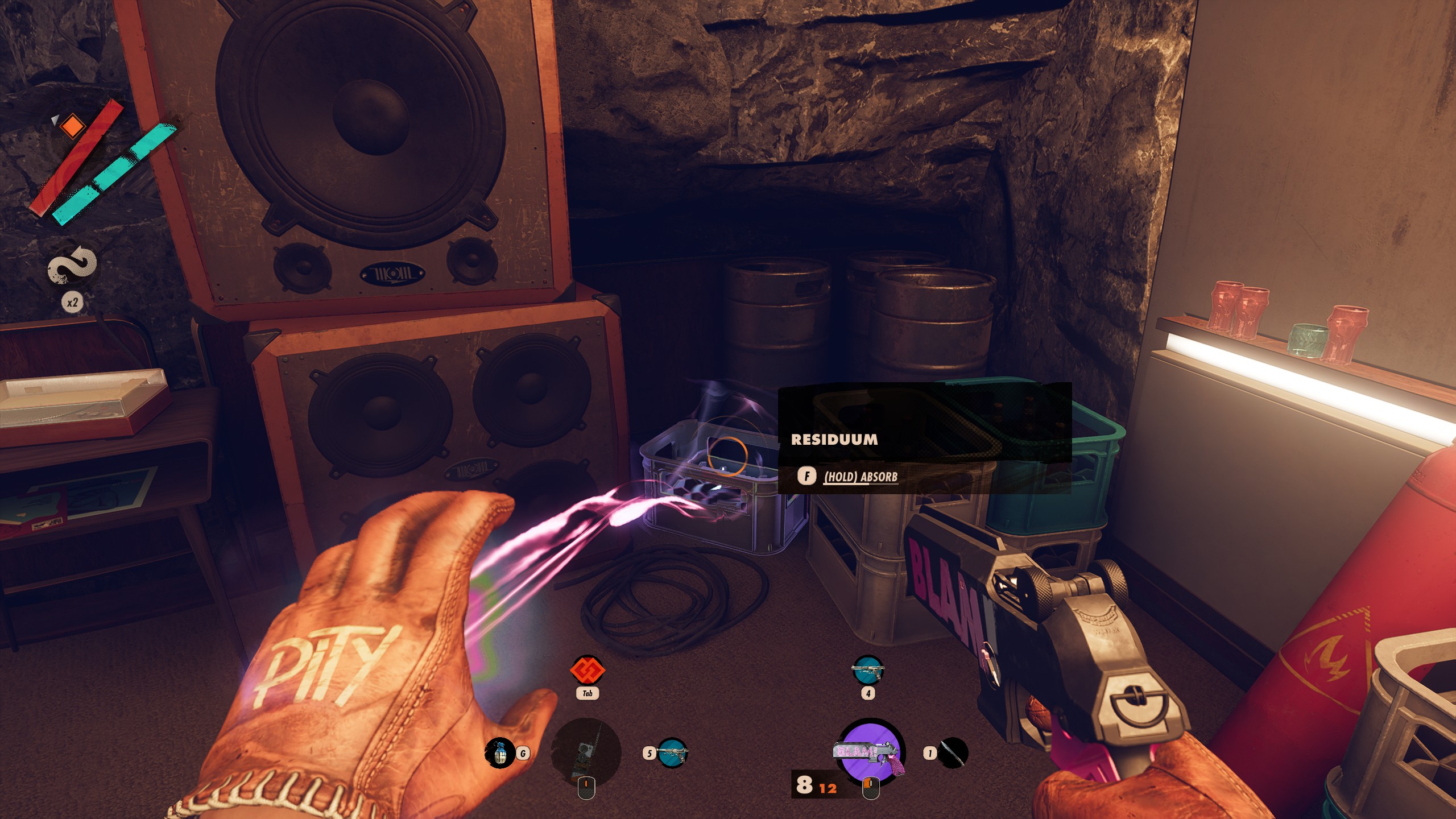 Soak up Residuum to bind useful weapons and power-ups during a given run.
Soak up Residuum to bind useful weapons and power-ups during a given run.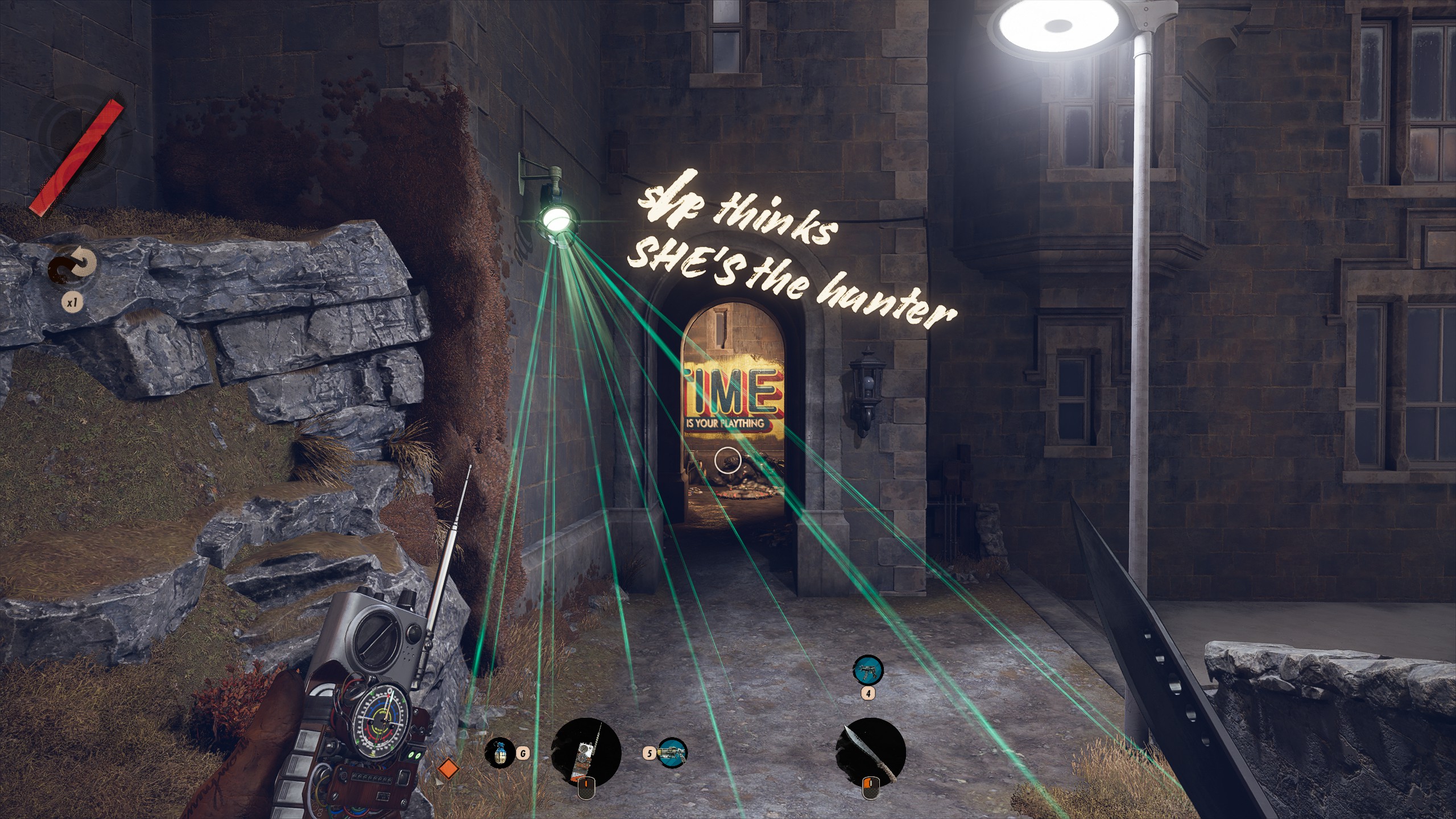 Hack any turrets, sensors, and other mechanical objects to take them over.
Hack any turrets, sensors, and other mechanical objects to take them over.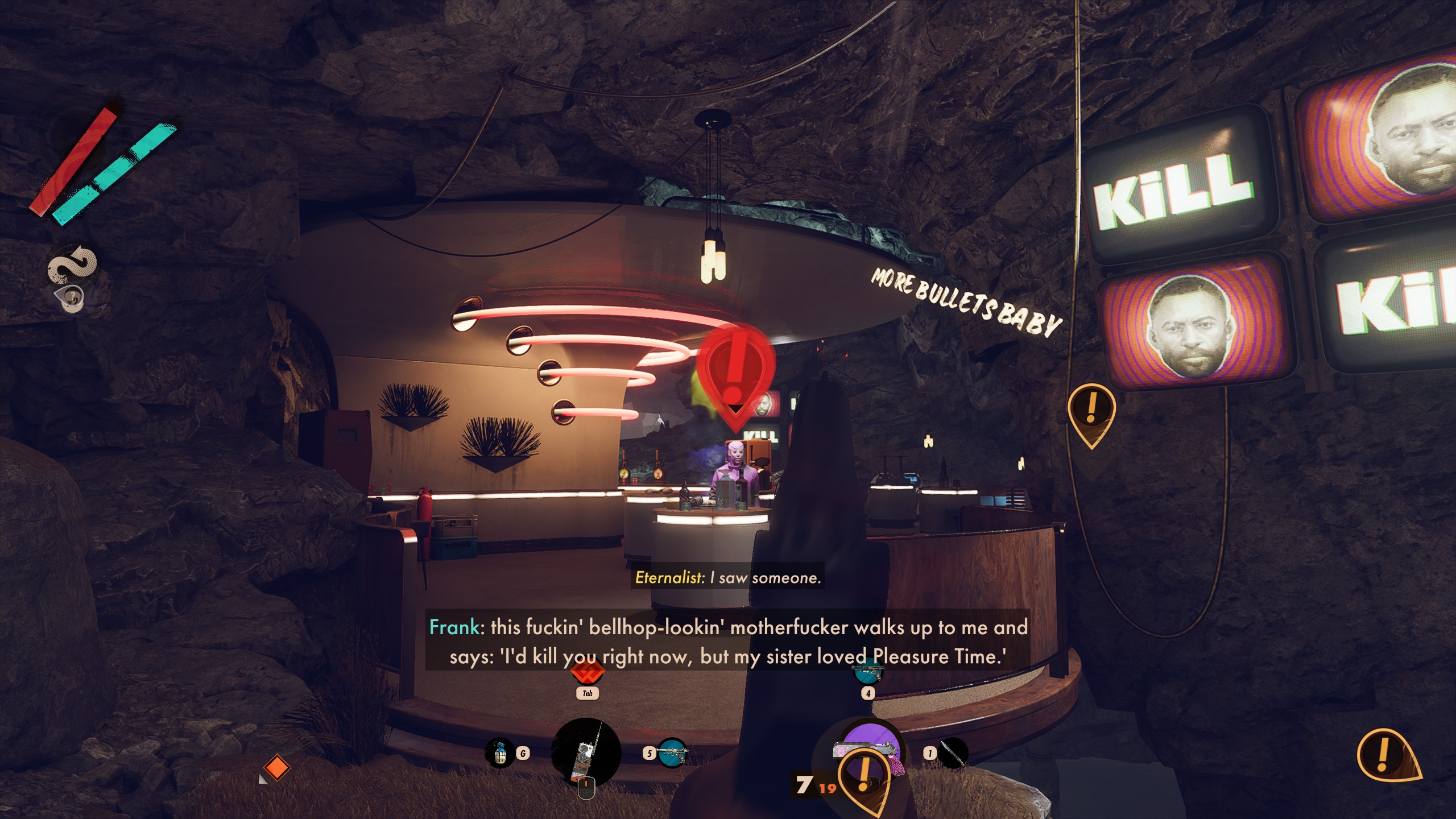 A shootout sometimes alerts nearby enemies, but much of the time, bad guys within earshot of your gunfire stand idly and let their friends die.
A shootout sometimes alerts nearby enemies, but much of the time, bad guys within earshot of your gunfire stand idly and let their friends die.
Had Arkane nailed Deathloop's sneak-and-strike combat system as well as it did in Dishonored, I might sing a different tune about this game's huge "Metroidvania" thrust. But Deathloop is currently an utter mess on the difficulty scale. To be clear, Arkane wants players to be mindful of when to attack and when to back off, since any swarm of more than four enemies will generally pulverize Colt in an open field. This can be pretty punishing, since the game only saves in between-mission checkpoints and wipes your Residuum points if you die without saving.
But dividing and conquering Blackreef Island's denizens is far too easy. Even at the game's toughest, most climactic points, I consistently "cheesed" my way to success by hiding in a corner, getting foes' attention, and picking them off one by one as they ran into my protected chamber. (This is even easier to do when you find and set up a portable turret, which are all over Blackreef for some reason.) Deathloop's enemies are basic, repetitive, and lack their own comfort-disrupting superpowers. I'm not sure why Arkane Lyon didn't broaden their variety, especially with a plot conceit that would have accounted for it.
Avoid “invasion,” and maybe avoid this game altogether
Unlike Dishonored, Deathloop offers a "game invasion" option, where players can become Julianna and invade other online players' sessions. However, as of the game's prerelease version, something is seriously, seriously off with its online networking model. The amount of lag I routinely faced while invading other players' games, or when they invaded mine, was enough to gut my interest in this mode entirely.
Even so, I still played as Julianna enough to determine that she truly has no interesting strategies to employ when messing with other real-world players. You can't lay traps. You can't remix or orchestrate the crowds of baddies that a Colt player must contend with. It's just a matter of running all over an island segment until you find Colt and then get into an awkward, lag-filled shootout. Since Julianna's progression doesn't unlock anything on the primary Colt side of the game, I didn't feel compelled to stick with it.
Worse, invading as Julianna sometimes means landing smack in the middle of a bad-guy scene that you haven't seen yet. If you're spoiler-averse, don't play as her. And if you hate the idea of real-world players invading your solo sessions, this whole thing can be disabled—though killing a player-controlled Julianna can cough up some nice bonuses.
Deathloop may ultimately go down as my biggest gaming disappointment of 2021. I love its "bonding" system for earning and keeping upgrades, which forces players to make some compelling choices from run to run. I like getting to know this game's cast of characters. I smile when a particular stretch of finding paths and sneaking around evokes the genius of this studio's best Dishonored levels. And I'm always down for shameless homages to Majora's Mask. But the total package collapses beneath a mix of too much ambition and not enough content. It's just hard to ignore signs that seem to imply someone on the production end said, "Eff it, let's ship this game already."
I would love to see Bethesda take Deathloop back, put more finishing touches on it, and re-release it as a "definitive" version. But I worry that the game's awkward status—announced as a console exclusive for Sony (which it still is), then completed after the studio had been acquired by Microsoft—means it will fall into a black hole, never to be seen again.
The good:
- Glimmers of compelling plot and character interactions.
- Some levels contain Arkane-caliber opportunities to hunt for sneaky paths and play the way you want.
The bad:
- The Majora's Mask-like take on time loops doesn't make up for how small, claustrophobic, and redundant the game feels.
- Stupid AI, humdrum enemies, and powerful abilities make it too easy to turn off your brain and plow through most of the game's potentially tricky moments.
- Visuals, level designs make it hard to understand why the game is locked to current-gen consoles.
- Bad netcode, uninteresting strategic options make the "invasion" mode a skippable snoozer.
The ugly:
- A pair of voiceover narrators are too intent on hating each other to clue-in players to what the heck is going on.
Verdict: Bethesda's biggest disappointment in years. Wait for a sale (or a "definitive" edition).
Listing image by Bethesda
"again" - Google News
September 13, 2021 at 07:01PM
https://ift.tt/3A3ksWy
Deathloop game review: Can Bethesda rewind this time loop and try again? - Ars Technica
"again" - Google News
https://ift.tt/2YsuQr6
https://ift.tt/2KUD1V2
Bagikan Berita Ini














0 Response to "Deathloop game review: Can Bethesda rewind this time loop and try again? - Ars Technica"
Post a Comment